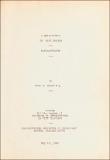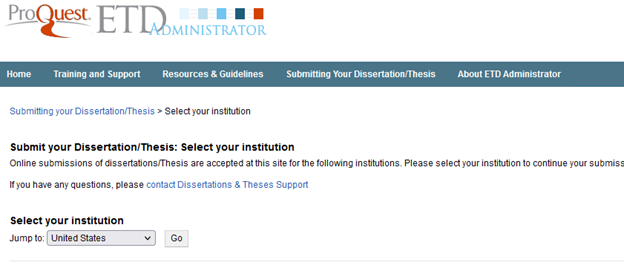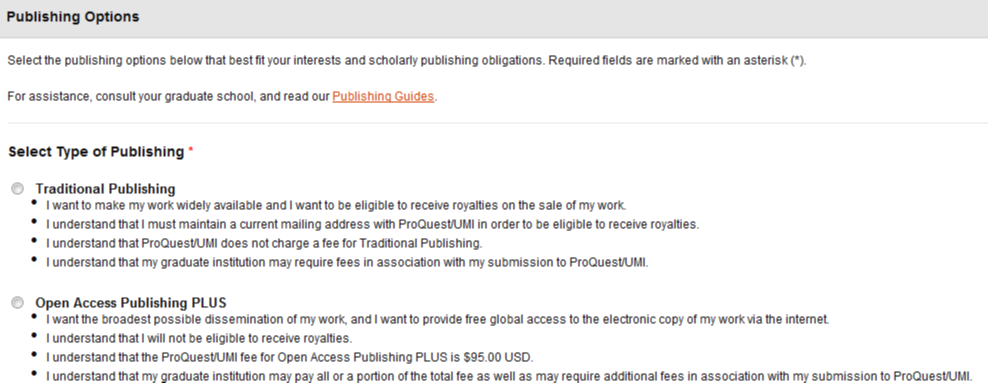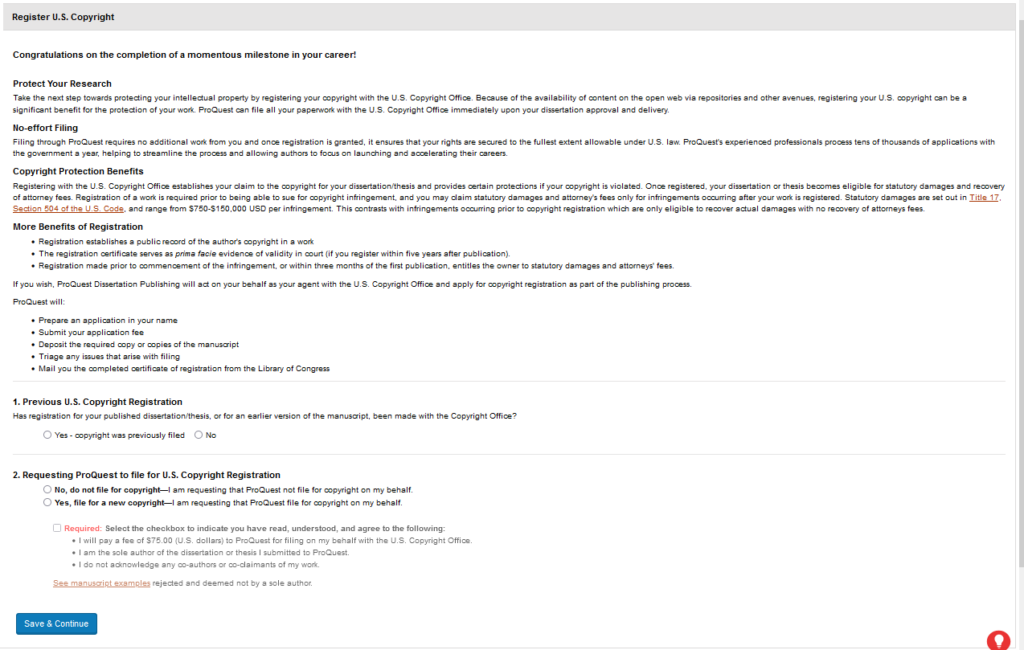Ohio State nav bar
The Ohio State University
- BuckeyeLink
- Find People
- Search Ohio State

Dissertations and Theses
The dissertation is the hallmark of the research expertise demonstrated by a doctoral student. It is a scholarly contribution to knowledge in the student’s area of specialization. By researching and writing a dissertation, the student is expected to demonstrate a high level of knowledge and the capability to function as an independent scholar.
A thesis is a hallmark of some master’s programs. It is a piece of original research, generally less comprehensive than a dissertation, and is meant to show the student’s knowledge of an area of specialization.
Document Preparation
PhD and master’s students are responsible for meeting all requirements for preparing theses and dissertations. They are expected to confer with their advisors about disciplinary and program expectations and to follow Graduate School procedure requirements.
The Graduate School’s format review is in place to help the document submission process go smoothly for the student. Format reviews for PhD dissertations and master’s theses can be done remotely or in-person. The format review is required at or before the two-week notice of the final defense.
Access and Distribution
Ohio State has agreements with two organizations— OhioLINK and ProQuest/UMI Dissertation Publishing —that store and provide access to Ohio State theses and dissertations.
Examinations
Graduate degree examinations are a major milestone in all graduate students’ pursuit of their graduate degree. Much hinges on the successful completion of these examinations, including the ability to continue in a graduate program.
The rules and processes set by the Graduate School ensure the integrity of these examinations for graduate students, the graduate faculty, and for Ohio State.
Final Semester
During your final semester as a graduate student there are many activities that lead up to commencement and receiving your degree. Complete the final semester checklist and learn more about commencement activities.
Graduation Calendar
Select your expected graduation term below to see specific dates concerning when to apply for graduation, complete your examinations and reports, submit approved thesis and dissertation, commencement, and the end-of semester deadline.
Applications to Graduate Due 1 : January 26, 2024
Examinations and Reports completed by 2 : April 12, 2024
Approved thesis and dissertation submitted and accepted by 3 : April 19, 2024
Commencement 4 : May 5, 2024
End of Semester Deadline 5 : May 6, 2024
Applications to Graduate Due 1 : May 24, 2024
Examinations and Reports completed by 2 : July 12, 2024
Approved thesis and dissertation submitted and accepted by 3 : July 19, 2024
Commencement 4 : August 4, 2024
End of Semester Deadline 5 : August 19, 2024
Applications to Graduate Due 1 : September 6, 2024
Examinations and Reports completed by 2 : November 22, 2024
Approved thesis and dissertation submitted and accepted by 3 : November 27, 2024
Commencement 4 : December 15, 2024
End of Semester Deadline 5 : January 3, 2025
Applications to Graduate Due 1 : January 24, 2025
Examinations and Reports completed by 2 : April 11, 2025
Approved thesis and dissertation submitted and accepted by 3 : April 18, 2025
Commencement 4 : May 4, 2025
End of Semester Deadline 5 : May 5, 2025
1 Applications to graduate include current semester or End-of-Semester deadline. Applications must be received by close of business.
2 Format reviews may occur electronically or in person at the Graduate School during announced business hours. Both options require submitting a digital version of the dissertation or DMA document draft in a PDF format to [email protected] .
3 Approved documents must be submitted via OhioLINK and accepted by the Graduate School by the close of business before the Report on Final Document will be processed.
4 Students not attending commencement must complete the commencement section on the Application to Graduate to indicate how their diploma should be disbursed.
5 A degree applicant who does not meet published graduation deadlines but who does complete all degree requirements by the last business day prior to the first day of classes for the following semester or summer term will graduate the following semester or summer term without registering or paying fees
Still Have Questions?
Dissertations & Theses 614-292-6031 [email protected]
Doctoral Exams, Master's Examination, Graduation Requirements 614-292-6031 [email protected]
Have a language expert improve your writing
Run a free plagiarism check in 10 minutes, generate accurate citations for free.
- Knowledge Base
- Dissertation
- Dissertation & Thesis Outline | Example & Free Templates
Dissertation & Thesis Outline | Example & Free Templates
Published on June 7, 2022 by Tegan George . Revised on November 21, 2023.
A thesis or dissertation outline is one of the most critical early steps in your writing process . It helps you to lay out and organize your ideas and can provide you with a roadmap for deciding the specifics of your dissertation topic and showcasing its relevance to your field.
Generally, an outline contains information on the different sections included in your thesis or dissertation , such as:
- Your anticipated title
- Your abstract
- Your chapters (sometimes subdivided into further topics like literature review, research methods, avenues for future research, etc.)
In the final product, you can also provide a chapter outline for your readers. This is a short paragraph at the end of your introduction to inform readers about the organizational structure of your thesis or dissertation. This chapter outline is also known as a reading guide or summary outline.
Table of contents
How to outline your thesis or dissertation, dissertation and thesis outline templates, chapter outline example, sample sentences for your chapter outline, sample verbs for variation in your chapter outline, other interesting articles, frequently asked questions about thesis and dissertation outlines.
While there are some inter-institutional differences, many outlines proceed in a fairly similar fashion.
- Working Title
- “Elevator pitch” of your work (often written last).
- Introduce your area of study, sharing details about your research question, problem statement , and hypotheses . Situate your research within an existing paradigm or conceptual or theoretical framework .
- Subdivide as you see fit into main topics and sub-topics.
- Describe your research methods (e.g., your scope , population , and data collection ).
- Present your research findings and share about your data analysis methods.
- Answer the research question in a concise way.
- Interpret your findings, discuss potential limitations of your own research and speculate about future implications or related opportunities.
For a more detailed overview of chapters and other elements, be sure to check out our article on the structure of a dissertation or download our template .
To help you get started, we’ve created a full thesis or dissertation template in Word or Google Docs format. It’s easy adapt it to your own requirements.
Download Word template Download Google Docs template

It can be easy to fall into a pattern of overusing the same words or sentence constructions, which can make your work monotonous and repetitive for your readers. Consider utilizing some of the alternative constructions presented below.
Example 1: Passive construction
The passive voice is a common choice for outlines and overviews because the context makes it clear who is carrying out the action (e.g., you are conducting the research ). However, overuse of the passive voice can make your text vague and imprecise.
Example 2: IS-AV construction
You can also present your information using the “IS-AV” (inanimate subject with an active verb ) construction.
A chapter is an inanimate object, so it is not capable of taking an action itself (e.g., presenting or discussing). However, the meaning of the sentence is still easily understandable, so the IS-AV construction can be a good way to add variety to your text.
Example 3: The “I” construction
Another option is to use the “I” construction, which is often recommended by style manuals (e.g., APA Style and Chicago style ). However, depending on your field of study, this construction is not always considered professional or academic. Ask your supervisor if you’re not sure.
Example 4: Mix-and-match
To truly make the most of these options, consider mixing and matching the passive voice , IS-AV construction , and “I” construction .This can help the flow of your argument and improve the readability of your text.
As you draft the chapter outline, you may also find yourself frequently repeating the same words, such as “discuss,” “present,” “prove,” or “show.” Consider branching out to add richness and nuance to your writing. Here are some examples of synonyms you can use.
| Address | Describe | Imply | Refute |
| Argue | Determine | Indicate | Report |
| Claim | Emphasize | Mention | Reveal |
| Clarify | Examine | Point out | Speculate |
| Compare | Explain | Posit | Summarize |
| Concern | Formulate | Present | Target |
| Counter | Focus on | Propose | Treat |
| Define | Give | Provide insight into | Underpin |
| Demonstrate | Highlight | Recommend | Use |
If you want to know more about AI for academic writing, AI tools, or research bias, make sure to check out some of our other articles with explanations and examples or go directly to our tools!
Research bias
- Anchoring bias
- Halo effect
- The Baader–Meinhof phenomenon
- The placebo effect
- Nonresponse bias
- Deep learning
- Generative AI
- Machine learning
- Reinforcement learning
- Supervised vs. unsupervised learning
(AI) Tools
- Grammar Checker
- Paraphrasing Tool
- Text Summarizer
- AI Detector
- Plagiarism Checker
- Citation Generator
When you mention different chapters within your text, it’s considered best to use Roman numerals for most citation styles. However, the most important thing here is to remain consistent whenever using numbers in your dissertation .
The title page of your thesis or dissertation goes first, before all other content or lists that you may choose to include.
A thesis or dissertation outline is one of the most critical first steps in your writing process. It helps you to lay out and organize your ideas and can provide you with a roadmap for deciding what kind of research you’d like to undertake.
- Your chapters (sometimes subdivided into further topics like literature review , research methods , avenues for future research, etc.)
Cite this Scribbr article
If you want to cite this source, you can copy and paste the citation or click the “Cite this Scribbr article” button to automatically add the citation to our free Citation Generator.
George, T. (2023, November 21). Dissertation & Thesis Outline | Example & Free Templates. Scribbr. Retrieved June 24, 2024, from https://www.scribbr.com/dissertation/dissertation-thesis-outline/
Is this article helpful?
Tegan George
Other students also liked, dissertation table of contents in word | instructions & examples, figure and table lists | word instructions, template & examples, thesis & dissertation acknowledgements | tips & examples, what is your plagiarism score.
Theses and Dissertations
Defense and submission.

Below is an overview of the main steps in preparing, defending, and submitting your thesis or dissertation. For detailed instructions on each step, see The Graduate School's Guide for Electronic Submission of Thesis and Dissertation (PDF) , in addition to this video recording from a workshop given on the subject.
- Schedule your defense and apply for graduation in DukeHub ( defense and graduation deadlines ).
- At least 30 days before your defense: Confirm or update your defense committee.
- Give your thesis/dissertation to your advisor for inspection, and prompt your advisor to send a letter to [email protected] stating that it is complete and ready to defend. Note: For students in School of Medicine Ph.D. programs, their advisor letters are generated through T3.
- Request your DGSA to send a departmental defense announcement to [email protected] . Note: For students in School of Medicine Ph.D. programs, their departmental defense announcements are generated through T3.
- At least 2 weeks before your defense: Submit your complete, correctly formatted dissertation/thesis to ProQuest (initial submission). Also provide it to each member of your committee.
- Optional: After you receive an email through ProQuest from the Graduate School administrator who reviewed your thesis/dissertation format, you may make an appointment for a brief, virtual meeting with the administrator to discuss any questions you have about the defense process or the recommended formatting revisions.
- A few days before your defense, The Graduate School will generate your final examination certificate and email it to the chair/co-chair(s) of your examination committee and the DGSA of your department. Note: For students in School of Medicine Ph.D. programs, their final examination certificates are generated and released through T3.
- Defend your dissertation. After your final examination, your committee members will vote on whether you passed or failed. Your chair and DGS will record the votes on your final examination certificate, sign it, and submit it to The Graduate School. Your committee may vote that you passed but still require minor edits or corrections before final submission.
- As soon as possible after your defense, submit to [email protected] the Non-Exclusive Distribution License and Thesis/Dissertation Availability Agreement (“embargo agreement”) signed by yourself and your thesis/dissertation advisor.
- Within 30 days after your successful defense, or by the established final submission deadline (whichever is first): Submit the final version of your dissertation/thesis to ProQuest.
Guide for Electronic Submission of Thesis and Dissertation (PDF)
We provide the following templates for your convenience and to help you eliminate common formatting errors. However, all submitted theses and dissertations must meet the specifications listed in the ETD guide . The manuscript must be a completed document, formatted correctly, with no sections left blank.
- Word Template for Thesis/Dissertation (Word)
- LaTeX Template for Thesis/Dissertation (ZIP)
Notes about the LaTeX Template
- This LaTeX template is for both master's and Ph.D. students. Master's theses must also have an abstract title page.
- Neither The Graduate School nor OIT supports LaTeX beyond providing this template.
Ph.D. and master’s students are required to apply for graduation in DukeHub by the established application deadline for the semester in which they plan to graduate.
Review the full graduation guidelines on the Graduation Information and Deadlines page.
When you submit your thesis or dissertation electronically, you will also permit Duke University to make it available online through DukeSpace at Duke Libraries. See the pages below for more information about ETDs:
- ETDs Overview
- ETD Availability
- ETD Copyright Information
- ETD Technical Help
Check out the writing support offered by The Graduate School, such as writing spaces, consultations, and access to online writing workshops, communities, and resources.
- A Guide to Writing a PhD Thesis
Written by Ben Taylor
A PhD thesis is a work of original research all students are requiured to submit in order to succesfully complete their PhD. The thesis details the research that you carried out during the course of your doctoral degree and highlights the outcomes and conclusions reached.
The PhD thesis is the most important part of a doctoral research degree: the culmination of three or four years of full-time work towards producing an original contribution to your academic field.
Your PhD dissertation can therefore seem like quite a daunting possibility, with a hefty word count, the pressure of writing something new and, of course, the prospect of defending it at a viva once you’ve finished.
This page will give you an introduction to what you need to know about the doctoral thesis, with advice on structure, feedback, submission and more.
Pick the right programme for you
There are lots of choices, let us help you to make the right one. Sign up to our weekly newsletter for the latest advice and guidance from our team of experts.
Beginning your PhD thesis
The first stage of your PhD thesis will usually be the literature review . We’ve already written a detailed guide to what the PhD literature review involves , but here’s what you need to know about this stage of your PhD:
- The literature review is a chance for you to display your knowledge and understanding of what’s already been written about your research area – this could consist of papers, articles, books, data and more
- Rather than simply summarising what other scholars have said about your subject, you should aim to assess and analyse their arguments
- The literature review is usually the first task of your PhD – and typically forms the first part or chapter of your dissertation
After finishing your literature review, you’ll move onto the bulk of your doctoral thesis. Of course, you’ll eventually return to the lit review to make sure it’s up-to-date and contains any additional material you may have come across during the course of your research.
PhD thesis research
What sets your PhD thesis apart from previous university work you’ve done is the fact that it should represent an original contribution to academic knowledge . The form that this original contribution takes will largely depend on your discipline.
- Arts and Humanities dissertations usually involve investigating different texts, sources and theoretical frameworks
- Social Sciences are more likely to focus on qualitive or quantitative surveys and case studies
- STEM subjects involve designing, recording and analysing experiments, using their data to prove or disprove a set theory
Depending on the nature of your research, you may ‘write up’ your findings as you go, or leave it until the dedicated ‘writing-up’ period, usually in the third year of your PhD. Whatever your approach, it’s vital to keep detailed notes of your sources and methods – it’ll make your life a lot easier when it comes to using references in your dissertation further down the line.
PhD thesis vs dissertation
It’s common to use the terms ‘thesis’ and ‘dissertation’ interchangeably, but strictly speaking there is a difference in meaning between them:
- Your thesis is your argument. It’s the conclusions you’ve arrived at through surveying existing scholarship in your literature review and combining this with the results of your own original research.
- Your dissertation is the written statement of your thesis. This is where you lay out your findings in a way that systematically demonstrates and proves your conclusion.
Put simply, you submit a dissertation, but it’s the thesis it attempts to prove that will form the basis of your PhD.
What this also means is that the writing up of your dissertation generally follows the formulation of your doctoral thesis (it’s fairly difficult to write up a PhD before you know what you want to say!).
However, it’s normal for universities and academics to use either (or both) terms when describing PhD research – indeed, we use both ‘thesis’ and ‘dissertation’ across our website.
Can I use my Masters research in my PhD thesis?
If you’re studying an MPhil, it’s normal to ‘ upgrade ’ it into a PhD. Find mroe information on our guide.
PhD thesis structure
Having completed your initial literature review and conducted your original research, you’ll move onto the next phase of your doctoral dissertation, beginning to sketch out a plan that your thesis will follow.
The exact structure and make-up of your doctoral thesis will vary between fields, but this is the general template that many dissertations follow:
- Introduction – This sets out the key objectives of your project, why the work is significant and what its original contribution to knowledge is. At this point you may also summarise the remaining chapters, offering an abstract of the argument you will go on to develop.
- Literature review – The introduction will generally lead into a write-up of your literature review. Here you’ll outline the scholarly context for your project. You’ll acknowledge where existing research has shaped your PhD, but emphasise the unique nature of your work.
- Chapters – After you’ve finished introducing your research, you’ll begin the bulk of the dissertation. This will summarise your results and begin explaining the argument you have based on them. Some PhDs will also include specific chapters on methodology and / or a recreation of the data you have developed. Others will develop your argument over a series of stages, drawing on sources and results as relevant.
- Conclusion – The dissertation will end with a final chapter that pulls together the different elements of your argument and the evidence you have provided for it. You’ll restate the significance of your project (and its all-important original contribution to knowledge). You may also take the opportunity to acknowledge the potential for further work or opportunities to apply your findings outside academia.
- Bibliography and appendices – At the end of your thesis, you’ll need to include a full list of the books, articles and data you’ve referenced in a bibliography. You may also need to provide additional information in the form of an appendix.
How long is a PhD thesis?
The length of a PhD thesis varies from subject to subject, but all are far longer than those for undergraduate or Masters degrees. Your university will usually set an upper limit – typically between 70,000 and 100,000 words, with most dissertations coming in at around 80,000 words.
Generally speaking, STEM-based theses will be a little shorter than those in the Arts, Humanities and Social Sciences.
Different universities (and departments) will have different policies regarding what counts towards the PhD thesis word count, so make sure you’re aware what is expected of you. Check with your supervisor whether references, the bibliography or appendices are included in the word count for your dissertation.
How many chapters should a PhD thesis have?
There’s no hard and fast rule for the numbers of chapters in a PhD thesis, but most will have four or five chapters (in addition to the introduction and conclusion). This is the sort of thing you’ll discuss with your supervisor when planning out your research.
Writing up your PhD thesis
Once you’ve conducted your research and settled upon your thesis, there’s only one thing left to do: get it down on paper. Appropriately enough, this final part of a PhD is often referred to as the ‘ writing up period ’.
This is when you produce the final dissertation, which will be submitted as the basis for your viva voce exam. The nature of this task can vary from PhD to PhD.
In some cases you may already have a large amount of chapter drafts and other material. ‘Writing up’ therefore becomes a process of re-drafting and assembling this work into a final dissertation. This approach is common in Arts and Humanities subjects where PhD students tend to work through stages of a project, writing as they go.
Alternatively, you may have spent most of your PhD collecting and analysing data. If so, you’ll now ‘write up’ your findings and conclusions in order to produce your final dissertation. This approach is more common in STEM subjects, where experiment design and data collection are much more resource intensive.
Whatever process you adopt, you’ll now produce a persuasive and coherent statement of your argument, ready to submit for examination.
PhD thesis feedback
Your supervisor will usually give you feedback on each chapter draft, and then feedback on the overall completed dissertation draft before you submit it for examination. When the thesis is a work-in-progress, their comments will be a chance for them to make sure your research is going in the right direction and for you to ask their advice on anything you’re concerned about. This feedback will normally be given in the form of a supervisory meeting.
Although your PhD supervisor will be happy to give you advice on your work, you shouldn’t expect them to be an editor – it’s not their responsibility to correct grammatical or spelling mistakes, and you should make sure any drafts you submit to them are as error-free as possible. Similarly, they won’t be willing to edit your work down to fit a particular word count.
Finishing your PhD thesis
When you’ve finished the final draft of your doctoral thesis and it’s been approved by your supervisor, you’ll submit it for examination. This is when it’s sent to the examiners who will conduct your viva.
Submitting your thesis involves printing enough copies for your examiners and the university’s repository. Don’t leave this until the last minute – printing multiple copies of a 300-page document is a substantial undertaking and you should always allow enough time to account for any possible glitches or issues with the printing process.
Your viva will usually take place within three months of submitting your thesis. You can find out more in our dedicated guide to the PhD viva . After your viva, your examiners will give you a report that confirms whether or not you need to make any changes to your thesis, with several different potential outcomes:
- Pass – You’ve received your doctoral qualification!
- Minor corrections – These are usually fairly small edits, tweaks and improvements to your thesis, which you’ll be given three months to implement
- Major corrections – For these substantial changes, you may have to rewrite part of your dissertation or complete extra research, with a six-month deadline
Most PhD students will need to fix some corrections with their thesis (hopefully not major ones). It’s very rare for a dissertation to be failed.
Once you’ve made any necessary changes to your thesis, you’ll submit it one last time (usually electronically).
If you have plans to publish all or part of your work, you may want to request an embargo so that it won’t be visible to the public for a certain time. 12 months is a fairly standard time period for this, although you may want to ask for a longer embargo if you know that you want to turn your thesis into a book or monograph.
Take a look at our programme listings and find the perfect PhD for you.
Our postgrad newsletter shares courses, funding news, stories and advice
You may also like....

The PhD is the most common variety of doctorate, but others are awarded in specific disciplines or sometimes particular countries.

Joint PhD programmes involve collaboration between two (or more) different universities. So how does that work? Who can apply? And what are the advantages (and disadvantages) of researching in this way?

Integrated PhD programmes consist of a one-year Masters followed by three years of PhD research. Find out more about what it's like to study an integrated PhD, how to apply and the funding options available.

Thinking of applying for the Doctor of Engineering (EngD)? Our guide covers everything you need to know about the qualification, including costs, applications, programme content, and how it differs from a PhD.

A PhD isn't the only option for postgraduate researchers. Our guides explain professional doctorates, joint degrees and compare other qualification types.

How does the value of an MPhil compare with a PhD, and why might you choose the Masters over the doctorate?
FindAPhD. Copyright 2005-2024 All rights reserved.
Unknown ( change )
Have you got time to answer some quick questions about PhD study?
Select your nearest city
You haven’t completed your profile yet. To get the most out of FindAPhD, finish your profile and receive these benefits:
- Monthly chance to win one of ten £10 Amazon vouchers ; winners will be notified every month.*
- The latest PhD projects delivered straight to your inbox
- Access to our £6,000 scholarship competition
- Weekly newsletter with funding opportunities, research proposal tips and much more
- Early access to our physical and virtual postgraduate study fairs
Or begin browsing FindAPhD.com
or begin browsing FindAPhD.com
*Offer only available for the duration of your active subscription, and subject to change. You MUST claim your prize within 72 hours, if not we will redraw.

Do you want hassle-free information and advice?
Create your FindAPhD account and sign up to our newsletter:
- Find out about funding opportunities and application tips
- Receive weekly advice, student stories and the latest PhD news
- Hear about our upcoming study fairs
- Save your favourite projects, track enquiries and get personalised subject updates

Create your account
Looking to list your PhD opportunities? Log in here .
Thesis & Dissertation Guidelines
These guidelines provide students at Vanderbilt University with essential information about how to prepare and submit theses and dissertations in a format acceptable to the Graduate School. You can either explore the guidelines by topic below or review the complete Format Guidelines document .
General Information
Manuscript preparation.
- NEW: Dissertation Template
- Approved LATEX Template for Dissertations
Submission Requirements
Students in foreign language departments may submit manuscripts in a language other than English. The abstract, however, must be in English.
You may use a multi-part presentation format for combining original research that has been conducted in two or more related or non-related areas, or for presentation of combined journal articles (published or submitted for publication). You should organize the parts or articles into chapters, with well-defined subheadings, including an introduction, methods, results and discussion. Each chapter may contain its own list of references and appendices, or you may list them all at the end, depending on the custom of your discipline.When using this format, the thesis or dissertation should nonetheless consist of an integrated argument that binds the chapters together. You should include the appropriate preliminary pages, an introduction presenting the general theme of the research, and a conclusion summarizing and integrating the major findings. Any additional appendices related to the dissertation as a whole or any general references from the introduction, conclusion or transitional sections should come at the end of the dissertation.
When you have previously published portions of your thesis or dissertation as an article or book chapter, you must ensure the work may also be published as part of the dissertation or thesis. The standard provisions of copyright law regarding quoted and previously published material under copyright apply to the publication of theses and dissertations. Many publishers provide exceptions to work published as part of graduation requirements and this is often clearly outlined as part of the publication agreement signed by the author.In order to include your own previously published or co-authored material in your thesis or dissertation, you must comply with the following:
- You must be the first author, or obtain permission from your committee, to be uploaded as an Administrative file in Vireo.
- The article must be based on research completed while you were enrolled at Vanderbilt University.
- You must have permission from the publisher to reuse the work, which should be uploaded to VIREO as an Administrative file. The record of permission may take the form of the publishing agreement, a copy of the publisher’s webpage describing reuse rights, or an email approval from the publisher. You should also identify which chapters are associated with which articles when prompted within VIREO.
- If there are co-authors, you must obtain the permission of all co-authors to include the work in the thesis or dissertation as a matter of both copyright law and professional courtesy. Include these permissions (email approval is acceptable) as an Administrative file in VIREO.
- You must properly acknowledge previously published material and any co-authors within the text of your manuscript. This would typically take the form of a footnote, or, alternately, an italicized statement beneath the relevant chapter heading. The rubric should be: “This chapter is adapted from [Title] published in [Journal] and has been reproduced with the permission of the publisher and my co-authors [List co-authors]” and include the full citation required by the publisher, if any, or appropriate to your discipline.
If the work is submitted to the ProQuest database, ProQuest will scan the document to ensure it contains no copyrighted material without consent and proper citation.
Inclusion of Third-Party Content
If you are including content in your dissertation not authored or created by you, consider copyright issues. If your use of the content would exceed fair use under the Copyright Act, then you will need to seek the copyright holder’s permission in order to use the material. Obtaining copyright permissions often takes time and should not be left until the last minute.You should discuss questions about copyrighted material with your dissertation advisor or contact the VU Librarian for Copyright and Scholarly Communications at [email protected] for help evaluating fair use or obtaining permissions.
Your thesis or dissertation is automatically protected by copyright as soon as it is fixed in a tangible form, such as being saved as an electronic file. Although not required, it is good practice to include the copyright symbol, your name, and the year on the title page of your work (© 2017 by [your name]).You also may choose to register your copyright, which will gain you additional protections in case of litigation for copyright infringement. You can file a copyright registration online directly with the U.S. Copyright Office for a fee of $45.00.
You will be asked to agree to the license to deposit your submission to the Vanderbilt Institutional Repository. The Library, with the Vanderbilt Institutional Repository, enhances the metadata provided with your dissertation and adds your record to discovery tools like the Library Catalog and WorldCat, making it easily findable for scholars worldwide. The library also maintains the technical infrastructure of the repository. If you plan to make your dissertation open access, we can assist you in understanding the options for licensing. If your dissertation makes use of copyrighted content, you will want to think early on about whether you may rely on fair use or need to acquire licenses. We will be glad to meet with you to discuss the requirements of your particular project.PhD students also have the option to request deposit of your submission with ProQuest, at no additional cost to you. If you elect to deposit your submission with ProQuest, you must also agree to the ProQuest license. This agreement is entirely between you and ProQuest. Vanderbilt’s sole responsibility is to pass on the license agreement and your work to ProQuest. Please contact ProQuest Dissertation Publishing, at 1(800) 521-0600 or [email protected] with any questions.
The expectation of the Graduate School is that all theses and dissertations will be made publicly available absent these limited circumstances. You have the option to make your submission available immediately or to temporarily embargo its release for a limited period of time. Students may elect to embargo their work if they anticipate publication, are making a patent application, have restrictions imposed by sponsors, or privacy concerns. Metadata, including the abstract, about your submission will still be visible in the Vanderbilt Institutional Repository, thereby indicating that your submission was accepted. You should discuss any anticipated hold on publication with your advisor. If selecting the ProQuest publishing option, be sure that you make the same embargo selection under the Vanderbilt options. Once your submission has been released to ProQuest, we have no ability to retract it.If, after consultation with your advisor, you would like to request a temporary embargo, you can elect from the following:
- No embargo and release immediately for worldwide access
- Six (6) month embargo
- Twelve (12) month embargo
- Twenty-four (24) month embargo
If you, after consultation with your advisor, determine that you need to extend your embargo beyond your initial selection, you can only do so with permission from the Graduate School. If you have questions about your embargo, you may email [email protected]
The Graduate School recommends Campus Copy for procuring bound copies of theses and dissertations. You may contact them directly at 615-936-4544, or online at Printing Services .
These guidelines provide students at Vanderbilt University with essential information about how to prepare and submit theses and dissertations in a format acceptable to the Graduate School. The topics range from writing style to the completion of required forms. There are instructions and sample pages on the Graduate School website for guidance through this process.
There is a distinct difference between submitting a manuscript to a publisher and providing a completed thesis or dissertation to the Graduate School. A manuscript represents a pre-publication format; a thesis or dissertation is a final, completely edited, published document. Students should use these guidelines, not other style manuals, as the final authority on issues of format and style. Areas not covered in this document or deviation from any of the specifications should be discussed with a Graduate School format editor. Do not use previously accepted theses and dissertations as definite models for style.
Manuscripts consist of four major sections and must be placed in the order listed:
- Title Page (required)
- Copyright (optional)
- Dedication (optional)
- Acknowledgments/Acknowledgment of Support (optional)
- Table of Contents (required)
- List of Tables (required, if tables are in the body of the manuscript)
- List of Figures (required, if figures are in the body of the manuscript)
- List of Abbreviations/Nomenclature/Symbols (optional)
- Introduction (may be referred to as Chapter 1)
Body of Manuscript
- References (required)
- Appendices (optional)
The dedication is an optional portion of the academic manuscript. It is a personal message from the author in tribute to a person, group, or cause. Most dedications are brief statements beginning with “To…” or “For…” such as “To my family” or “For my daughter, Samantha.” The dedication, if any, is considered to be the sole work of the author and does not reflect endorsement of the views and opinions expressed therein by Vanderbilt University, the Graduate School, or the members of the faculty committee.
The acknowledgment is another optional portion of the academic manuscript. It is appropriately used to thank those people and organizations that have helped or encouraged the author in the process of obtaining the degree or otherwise making the graduate degree possible: advisers, the committee, labmates or members of one’s cohort, family, friends, etc. Typically, an acknowledgment is no more than 1 page in length.Acknowledgment of grant/contract or other financial support may be included on the acknowledgment page. Similarly, permission to reprint copyrighted material may be included here.The acknowledgment, if any, is considered to be the sole work of the author and does not reflect endorsement of the views and opinions expressed therein by Vanderbilt University, the Graduate School, or the members of the faculty committee.
The abstract is a separate document from the manuscript; it is not bound with the thesis or dissertation. Abstracts must be printed on white, 8 ½ x 11-inch paper. No page numbers are printed on the abstract. One copy is required. Abstracts must have the original signature(s) of the faculty advisor(s). The maximum length of the thesis abstract is 250 words. The maximum length of the dissertation abstract is 350 words, including the dissertation title. Majors are listed on the last pages of these guidelines. NEW: Abstract sample
The title page must be printed on white, 8 ½ x 11-inch paper. Committee member signatures on the title page must be originals. Spacing on the title page will vary according to the length of the title. The five lines following your name must be formatted exactly as found on the sample title page. The title page is considered page ‘i’ but the page number is not printed on the page. The month, day, and year representing the conferral date must be listed on the title page.
- NEW: ETD Title Page sample
- NEW: Title Page With Signatures sample
Use a standard font consistently throughout the manuscript. Font size should be 10 to 12-point for all text, including titles and headings. It is permissible to change point size in tables, figures, captions, footnotes, and appendix material. Retain the same font, where possible. When charts, graphs, or spreadsheets are “imported,” it is permissible to use alternate fonts. Italics are appropriate for book and journal titles, foreign terms, and scientific terminology. Boldface may be used within the text for emphasis and/or for headings and subheadings. Use both in moderation.
Measure the top margin from the edge of the page to the top of the first line of text. Measure the bottom page margin from the bottom of the last line of text to the bottom edge of the page. Page margins should be a minimum of one-half inch from top, bottom, left, and right and a maximum of one inch from top, bottom, left, and right. Right margins may be justified or ragged, depending upon departmental requirements or student preference.
The title page is considered to be page ‘i’ but the page number should not be printed on this page. All other pages should have a page number centered about ½ inch from the bottom of the page. Number the preliminary pages in lowercase Roman numerals. Arabic numerals begin on the first page of text. Pages are numbered consecutively throughout the remainder of the manuscript. The Introduction may be placed before the first page of Chapter 1, if it is not considered a chapter. The use of Arabic numbers may begin on the first page of the Introduction.
The entire text may be single-spaced, one and one-half spaced, or double-spaced. Block quotations, footnotes, endnotes, table and figure captions, titles longer than one line, and individual reference entries may be single-spaced. With spacing set, the following guidelines should be applied: Two enters after chapter numbers, chapter titles and major section titles (Dedication, Acknowledgements, Table of Contents, List of Tables, List of Figures, List of Abbreviations, Appendices, and References). Two enters before each first- level and second-level heading. Two enters before and after tables and figures embedded in the text. One enter after sub-level headings.
Chapters may be identified with uppercase Roman numerals or Arabic numbers. Styles used on the Table of Contents should be consistent within the text. Tables, figures, footnotes, and equations should be numbered consecutively throughout the manuscript with Arabic numerals. These may also be numbered consecutively by each chapter. Equation numbers should be placed to the right of the equation and contained within parentheses or brackets. Use uppercase letters to designate appendices.
Departments will determine acceptable standards for organizing master’s theses into chapters, sections, or parts. Usually, if a thesis has headings, a Table of Contents should be included. The dissertation must be divided into chapters. The use of parts, in addition to chapters, is acceptable.
Words and Sentences
Take care to divide words correctly. Do not divide words from one page to the next. Word processing software provides for “widow and orphan” protection. Utilize this feature to help in the proper division of sentences from one page to another. In general, a single line of text should not be left at the bottom or top of a page. Blank space may be left at the bottom of a page, where necessary.
Headings and Subheadings
Use headings and subheadings to describe briefly the material in the section that follows. Be consistent with your choice of “levels” and refer to the instructions on spacing for proper spacing between headings, subheadings, and text. First-level headings must be listed on the Table of Contents. Second-level and subsequent subheadings may be included.
Acronyms/Abbreviations/Capitalization
Abbreviations on the title page should appear as they do in the body of the thesis or dissertation. (Examples: Xenopus laevis , Ca, Mg, Pb, Zn; TGF-β, p53.) Capitalize only the first letter of words of importance, distinction, or emphasis in titles and headings. Do not alter the all-cap style used for acronyms (Example: AIDS) and organizational names (Example: IBM). Use the conventional style for Latin words (Examples: in vitro, in vivo, in situ ). Genus and species should be italicized. Capitalize the first letter of the genus, but not that of the species name (Example: Streptococcus aureus ).
Figures commonly refer to photographs, images, maps, charts, graphs, and drawings. Tables generally list tabulated numerical data. These items should appear as close as possible to their first mention in the text. Tables and figures may be placed in appendices, if this is a departmental requirement or standard in the field. Tables and figures should be numbered with Arabic numerals, either consecutively or by chapter. Be consistent in the style used in the placement of tables and figure captions. Tables and figures may be embedded within the text or placed on a page alone. When placed on its own page, a figure or table may be centered on the page. When included with text, a table or figure should be set apart from the text. Tables and figures, including captions, may be oriented in landscape. Make sure to use landscape page positioning on landscape-oriented pages. Table data and figure data must be kept together, if the information fits on one page.
The submission process for theses and dissertations begins at the Graduate School. Forms must be digitally submitted to the Graduate School. View the Checklist for Graduation
The Vanderbilt Libraries have recently implemented VIREO , an Electronic Thesis & Dissertation review and submission system for the Graduate School. The Graduate School requires electronic submission of all theses and dissertations through this new platform. Format reviews now occur within the VIREO submission process. If you have questions or would like an in-person format review, contact administrators .Students will use their VUnet ID and password to log in and begin completing the appropriate information, as outlined below.
Verify Your Information
- Orcid ID (can obtain in VIREO)
- Department/Program, Degree, Major
- Phone & Address
License & Publication Agreements
- Vanderbilt License Agreement (required)
- ProQuest Publication (optional)
Document Information
- Title, degree month/year, defense date, abstract, keywords, subjects, language
- Your committee, Chair email
- Previously published material (optional)
- Embargo options
Upload Your Files
- Primary document: thesis/dissertation
- Additional files: supplemental, source, administrative (CV, Survey of Earned Doctorates (additional SED information is in the Ph.D. Dissertation Requirements accordion below))
Confirm and Submit
- Students will receive a confirmation email once submitted
Any documents you will be uploading into VIREO as administrative files should be saved as a PDF, and named with your last name, first name-file-conferral month and year. Examples:
- King, Amanda-IntraTermApp-032021.pdf
- King, Amanda-CV-052021.pdf
- King, Amanda-SED-052021.pdf
- King, Amanda-Title Page-052021.pdf
- King, Amanda-Permissions-052021.pdf
- King, Amanda-DGS Approval-052021.pdf
Intent to Graduate
Students planning to graduate at the end of the fall, spring, or summer term should submit the Intent to Graduate form through YES by clicking on Graduation – Intent. Note that all masters students should submit this form , even if they are receiving a master’s in passing to the PhD.
Format Review
A format review is required before thesis or dissertation approval. Review will take place through VIREO when you first upload your document. Allow time before the deadline for review and revisions. For questions contact [email protected] .
Submit one copy of the title page, with original signatures of the advisor and a second reader (either a member of the committee or DGS of the program). The date on the title page will reflect the month, day, year of degree conferral.
Submit one copy of the abstract with the signature of the advisor.
Intent to Graduate
Students planning to graduate at the end of the fall, spring, or summer term should submit the Intent to Graduate form through YES by clicking on Graduation – Intent.
Defense Results
Students must schedule the Defense Exam with the Graduate School two weeks prior to the exam. Students will bring the Defense Results Form (along with the Title Page & Abstract) to obtain committee signatures. Upload the signed title page and abstract as one administrative file (title page first followed by abstract) to VIREO as an administrative file, and have your department submit the defense results to the graduate school submissions portal.
Upload your signed title page as an administrative file in VIREO. The date on the title page will reflect the month, day, year of degree conferral. Be sure it is the date of conferral and not the date of your defense.
Upload your signed abstract as an administrative file in VIREO.
Survey of Earned Doctorates (SED)
Students finishing a doctorate degree are required to complete the SED survey . Information provided to the National Opinion Research Council remains confidential and will be used for research or statistical purposes. Submit the Certificate of Completion with your VIREO submission as an administrative file.
Curriculum Vitae
Submit your CV through your VIREO submission as an administrative file. Directions on preparing a curriculum vitae are available here.
Graduate Education
Office of graduate and postdoctoral education, theses & dissertations.

Review the thesis deadlines, including deadlines for the initial format check and required forms.

Thesis Manual
Read over the Thesis and Dissertation Manual for an overview of document and format guidelines and more.

View the checklist of required documents for thesis submission.

Access needed forms for the thesis and dissertation process.

Format your thesis or dissertation using our thesis format templates.
Resources to Help You Through the Process
Whether you need to make an appointment or need guidance about copyright rules, the following resources are available to support you:
Spring 2024 Thesis Info Session Resources
- Watch the Thesis Information Session presentation
- Access the Thesis Information Session presentation slide deck
Virtual Thesis & Dissertation Appointments
The Graduate Education Thesis and Dissertation coordinator is offering virtual appointments for questions related to:
- Thesis/dissertation process
- Format checking feedback
- Graduation policies and procedures
- Read about copyright information
- Attend Library classes and events
- Learn about citation tools
- Connect with subject expert librarians
- Access Library theses and dissertation resources
Conducting & Communicating Research
- Including Previously-Published Work in Dissertation
- Effective and Responsible Use of AI in Research (updated October 30, 2023)
- Ethical and Responsible Use of AI in Research Projects Presentation
- Connect with the Naugle CommLab
Pathways to Graduation
Have questions about graduation? Not sure where to begin? The Office of Graduate Education has developed Pathways to Graduation , a self-guided Canvas course which helps to equip graduate students with the tools to succeed and experience a smooth, stress-free road to graduation.
Many policies related to this process are listed in Georgia Tech’s Policy Library. For international students, there are Office of International Education policies on enrollment and optional practical training that you’ll want to become familiar with.
Graduate Thesis Faculty Submission Form
Effective for the summer 2023 term, the policy on advisement of graduate students has been updated in the Catalog . Tenure-track faculty are members of the Graduate Thesis Faculty by default. All other Georgia Tech faculty must be approved by the program and submitted to the Office of Graduate Education. Departments must submit those names, once approved, via our submission form below.
Electronic Submission and Disseminating Your Work
Tech requires all theses and dissertations to be submitted electronically. Once it is approved by your committee, here’s what happens next:
- Visit the Electronic Thesis and Dissertations (ETD) Submission System . Please follow the instructions, and upload your approved thesis or dissertation as a PDF.
- Graduate Education will check your uploaded PDF and will notify you if there are any corrections. You must make the corrections, and resubmit the corrected file.
- If Graduate Education has all the required pre-thesis and thesis-related (or dissertation) documents, we will approve your thesis/dissertation and notify the Office of the Registrar that you are eligible to graduate.
- You and your committee members will receive an approval notice via Vireo/ETD. Approximately a month after you graduate, your thesis/dissertation will be released for electronic circulation.
- You can request that your thesis/dissertation be withheld from release for one year for intellectual property reasons. The Graduate Thesis Office ( [email protected] ) must receive a written request from your advisor approving your request at the same time as you submit your other thesis documents. The Request for Withholding form is available via DocuSign.
When you’re ready to share your work with the public, check out the Georgia Tech Digital Repository on disseminating your thesis or dissertation.
Upcoming Defenses
To view the full listing of upcoming defenses, see MS and Ph.D. Defenses .
PhD Defense by Fernando Vasconcelos da Senhora
Phd defense by anirudh sivakumar, phd defense by aawaz pokhrel, phd proposal by jeffery noble, phd defense by grace guo.
Check our frequently asked questions (FAQ) to see if your question has already been answered. Else, contact [email protected] .
Accessibility Information
Download Microsoft Products > Download Adobe Reader >
- Make a gift
- ConnectCarolina
- Information for:
- Prospective students
- Current students
- Faculty and staff
- Alumni and friends
Thesis and Dissertation Resources
Here you can find resources and guidelines on how to prepare and submit your Thesis/Dissertation.
The Graduate School Thesis and Dissertation Guide
This Guide includes everything you need to know about what should be included in your final document, samples of specific sections, formatting guidelines, and a checklist for submitting your work.
Submit your thesis or dissertation
This link directs you to the ProQuest ETD Administrator site where you will set up an account and submit your completed electronic thesis or dissertation to The Graduate School.
The Graduate School Handbook
The Handbook provides additional information on master's thesis requirements or doctoral dissertation requirements .
Thesis and dissertation formatting workshops
- Dissertation formatting workshop: PC version
- Dissertation formatting workshop: Apple/Mac version
Stages of the thesis or dissertation process
These guidelines and advice will be helpful as you consider your thesis or dissertation from preparation through final submission.
Stages of the Thesis or Dissertation Process
Although you won't submit your thesis or dissertation until your final semester of graduate study, it is recommended that you begin thinking about many aspects of your thesis or dissertation much sooner.
- Use The Graduate School's Thesis and Dissertation Guide to aid in preparing and submitting your thesis or dissertation. Read through the guidelines early and refer back to them as often as needed throughout the process.
- Begin discussions with your advisor and committee early, as they may have useful information to impart to you as you begin your research and writing.
- Be sure to determine which style manual is appropriate for your discipline. Formatting is often easier when applied at the beginning of the writing process rather than at the end, especially when concerning citations.
- Review and discuss how copyrighting may impact your research and writing, including decisions about publishing your own work. The University Libraries' Scholarly Communications Office is a campus resource on scholarly publishing practices.
- Take advantage of campus resources such as workshops, University Libraries, and the Writing Center.
- As you approach your defense, set up your student account in the ProQuest ETD Administrator . Review the site for useful information about the online submission process.
- After your defense has occurred and all final edits are approved by your committee, plan to submit your thesis or dissertation. Follow the checklist and submission instructions in the Thesis and Dissertation Guide to prepare your document.
- In addition to uploading a PDF of your thesis or dissertation, be prepared to provide added information (e.g., abstract, keywords, and subject headings) about your work for indexing and identification purposes. This information will help make your work more discoverable online.
- After you have submitted your thesis or dissertation, check your email regularly for updates. Make any required revisions promptly.
- You will receive a final email notifying you that your ETD has been accepted. Once your document has been approved, you cannot make any further changes. ProQuest will make the title and abstract of your thesis or dissertation available online shortly after graduation. The University Libraries will make your thesis or dissertation available within one semester.
Frequently asked questions about electronic theses and dissertations
Follow the dates posted on The Graduate School's graduation deadlines website . Submit your thesis or dissertation after your defense has occurred and all final edits are approved by your advisor and committee. Your Committee Composition and Exam Report forms (with all approval signatures) must be submitted to The Graduate School before submitting your document.
The ETD Administrator uses statuses to help students and staff keep track of what step comes next during the ETD submission process. Some statuses require action on the part of the student while others indicate that staff are responsible for taking the next step. To help you understand what each status means, visit the ProQuest help page . You can also access this page from within the ETD Administrator by clicking on the “Help ?” link on the top right corner of most pages.
You should receive an email from the ETD Administrator immediately following submission of your thesis or dissertation. If you do not receive this email, please check your junk/spam folder and verify which email address you used when you set up your ETD Administrator account. You will continue to receive emails relating to time-sensitive required revisions, so it is important that you monitor the email account associated with your ETD Administrator account on a daily basis. You will receive a final email when The Graduate School has accepted the finalized document.
While you should receive emails notifying you of necessary changes, required revisions can also be viewed directly within the ProQuest ETD Administrator . To view required revisions:
- Login to your account
- Go to the “My Dissertations/Theses List”
- Click on the “View” button under the entry for your ETD
- Under “Manage this ETD” on the left margin, select “View decisions”
- A list of the decisions that have been made will be displayed in the middle of the page; on the far right of each decision is a link for “View Email”
- Click the “View Email” link to display the entire contents of the email that was sent to you, including any required revisions
Conflict of interest disclosures should be included in the Acknowledgements section of your document. Please contact [email protected] for more information.
The Thesis and Dissertation Guide has been designed as a comprehensive resource to aid you in preparing your thesis or dissertation for final acceptance and approval. If you have read the Guide and still have questions about the guidelines or submission process, email your Graduate School enrolled students specialist . Please note that Graduate School staff cannot offer formatting assistance. For technical assistance relating to the ETD Administrator submission website, contact ProQuest Tech Support or review the ETD Administrator Help pages .
Receipt of a submitted and approved thesis or dissertation in The Graduate School results in the publication of the document by the University Library at UNC-Chapel Hill. As such, each student grants the University a limited, non-exclusive, royalty-free license to reproduce the student's work, in whole or in part, in electronic form to be posted in the University Library database and made available to the general public at no charge. As a public institution, UNC-Chapel Hill is committed to disseminating research widely and furthering the free exchange of intellectual information, including approved theses and dissertations completed by graduating students. See the Thesis and Dissertation Guide Copyrighting section for information about the campus copyright policy.
Most students will not need to request an embargo. In certain circumstances (e.g., pending patent application, publisher requirements) it may be advisable to request one. If you would like to delay release of your thesis or dissertation, please discuss the advantages and disadvantages of an embargo with your advisor or academic program.
UNC-Chapel Hill only permits the request of a one or two year embargo – regardless of options and documentation displayed in ProQuest. If your request for an embargo is accepted by The Graduate School, online publishing of your thesis or dissertation will be delayed for one or two years. Please note that the title of your work, as well as your abstract, will be available through ProQuest Dissertations & Theses shortly after your work has been approved by The Graduate School and submitted to ProQuest. Please review the Thesis and Dissertation Guide Embargo section for more information.
The Open Access, full text of your thesis or dissertation will be available online through the UNC Libraries . There is an approximately one semester delay for processing and uploading electronic theses and dissertations to the Library's digital collections.
Shortly after graduation, your thesis or dissertation title and abstract will be available through several ProQuest databases that can be accessed through the UNC Libraries.
If you chose to order optional printed copies of your thesis or dissertation in the ETD Administrator as part of the submission process, your order will be filled by ProQuest. Your order summary and manuscript ID are in your submission confirmation email. For questions about your order, you will need to contact ProQuest directly. Neither The Graduate School nor the University Libraries can offer information about past orders or requests for print copies.
What’s Included: The Dissertation Template
If you’re preparing to write your dissertation, thesis or research project, our free dissertation template is the perfect starting point. In the template, we cover every section step by step, with clear, straightforward explanations and examples .
The template’s structure is based on the tried and trusted best-practice format for formal academic research projects such as dissertations and theses. The template structure reflects the overall research process, ensuring your dissertation or thesis will have a smooth, logical flow from chapter to chapter.
The dissertation template covers the following core sections:
- The title page/cover page
- Abstract (sometimes also called the executive summary)
- Table of contents
- List of figures /list of tables
- Chapter 1: Introduction (also available: in-depth introduction template )
- Chapter 2: Literature review (also available: in-depth LR template )
- Chapter 3: Methodology (also available: in-depth methodology template )
- Chapter 4: Research findings /results (also available: results template )
- Chapter 5: Discussion /analysis of findings (also available: discussion template )
- Chapter 6: Conclusion (also available: in-depth conclusion template )
- Reference list
Each section is explained in plain, straightforward language , followed by an overview of the key elements that you need to cover within each section. We’ve also included practical examples to help you understand exactly what’s required in each section.
The cleanly-formatted Google Doc can be downloaded as a fully editable MS Word Document (DOCX format), so you can use it as-is or convert it to LaTeX.
FAQs: Dissertation Template
What format is the template (doc, pdf, ppt, etc.).
The dissertation template is provided as a Google Doc. You can download it in MS Word format or make a copy to your Google Drive. You’re also welcome to convert it to whatever format works best for you, such as LaTeX or PDF.
What types of dissertations/theses can this template be used for?
The template follows the standard best-practice structure for formal academic research projects such as dissertations or theses, so it is suitable for the vast majority of degrees, particularly those within the sciences.
Some universities may have some additional requirements, but these are typically minor, with the core structure remaining the same. Therefore, it’s always a good idea to double-check your university’s requirements before you finalise your structure.
Will this work for a research paper?
A research paper follows a similar format, but there are a few differences. You can find our research paper template here .
Is this template for an undergrad, Masters or PhD-level thesis?
This template can be used for a dissertation, thesis or research project at any level of study. It may be slight overkill for an undergraduate-level study, but it certainly won’t be missing anything.
How long should my dissertation/thesis be?
This depends entirely on your university’s specific requirements, so it’s best to check with them. As a general ballpark, Masters-level projects are usually 15,000 – 20,000 words in length, while Doctoral-level projects are often in excess of 60,000 words.
What about the research proposal?
If you’re still working on your research proposal, we’ve got a template for that here .
We’ve also got loads of proposal-related guides and videos over on the Grad Coach blog .
How do I write a literature review?
We have a wealth of free resources on the Grad Coach Blog that unpack how to write a literature review from scratch. You can check out the literature review section of the blog here.
How do I create a research methodology?
We have a wealth of free resources on the Grad Coach Blog that unpack research methodology, both qualitative and quantitative. You can check out the methodology section of the blog here.
Can I share this dissertation template with my friends/colleagues?
Yes, you’re welcome to share this template. If you want to post about it on your blog or social media, all we ask is that you reference this page as your source.
Can Grad Coach help me with my dissertation/thesis?
Within the template, you’ll find plain-language explanations of each section, which should give you a fair amount of guidance. However, you’re also welcome to consider our dissertation and thesis coaching services .

- Formatting Your Dissertation
- Introduction
Harvard Griffin GSAS strives to provide students with timely, accurate, and clear information. If you need help understanding a specific policy, please contact the office that administers that policy.
- Application for Degree
- Credit for Completed Graduate Work
- Ad Hoc Degree Programs
- Acknowledging the Work of Others
- Advanced Planning
- Dissertation Advisory Committee
- Publishing Options
- Submitting Your Dissertation
- English Language Proficiency
- PhD Program Requirements
- Secondary Fields
- Year of Graduate Study (G-Year)
- Master's Degrees
- Grade and Examination Requirements
- Conduct and Safety
- Financial Aid
- Non-Resident Students
- Registration
On this page:
Language of the Dissertation
Page and text requirements, body of text, tables, figures, and captions, dissertation acceptance certificate, copyright statement.
- Table of Contents
Front and Back Matter
Supplemental material, dissertations comprising previously published works, top ten formatting errors, further questions.
- Related Contacts and Forms
When preparing the dissertation for submission, students must follow strict formatting requirements. Any deviation from these requirements may lead to rejection of the dissertation and delay in the conferral of the degree.
The language of the dissertation is ordinarily English, although some departments whose subject matter involves foreign languages may accept a dissertation written in a language other than English.
Most dissertations are 100 to 300 pages in length. All dissertations should be divided into appropriate sections, and long dissertations may need chapters, main divisions, and subdivisions.
- 8½ x 11 inches, unless a musical score is included
- At least 1 inch for all margins
- Body of text: double spacing
- Block quotations, footnotes, and bibliographies: single spacing within each entry but double spacing between each entry
- Table of contents, list of tables, list of figures or illustrations, and lengthy tables: single spacing may be used
Fonts and Point Size
Use 10-12 point size. Fonts must be embedded in the PDF file to ensure all characters display correctly.
Recommended Fonts
If you are unsure whether your chosen font will display correctly, use one of the following fonts:
| Arial | 10 pt |
| Century | 11 pt |
| Courier New | 10 pt |
| Garamond | 12 pt |
| Georgia | 11 pt |
| Lucida Bright | 10 pt |
| Microsoft Sans Serif | 10 pt |
| Tahoma | 10 pt |
| Times New Roman | 12 pt |
| Trebuchet MS | 10 pt |
| Verdana | 10 pt |
If fonts are not embedded, non-English characters may not appear as intended. Fonts embedded improperly will be published to DASH as-is. It is the student’s responsibility to make sure that fonts are embedded properly prior to submission.
Instructions for Embedding Fonts
To embed your fonts in recent versions of Word, follow these instructions from Microsoft:
- Click the File tab and then click Options .
- In the left column, select the Save tab.
- Clear the Do not embed common system fonts check box.
For reference, below are some instructions from ProQuest UMI for embedding fonts in older file formats:
To embed your fonts in Microsoft Word 2010:
- In the File pull-down menu click on Options .
- Choose Save on the left sidebar.
- Check the box next to Embed fonts in the file.
- Click the OK button.
- Save the document.
Note that when saving as a PDF, make sure to go to “more options” and save as “PDF/A compliant”
To embed your fonts in Microsoft Word 2007:
- Click the circular Office button in the upper left corner of Microsoft Word.
- A new window will display. In the bottom right corner select Word Options .
- Choose Save from the left sidebar.
Using Microsoft Word on a Mac:
Microsoft Word 2008 on a Mac OS X computer will automatically embed your fonts while converting your document to a PDF file.
If you are converting to PDF using Acrobat Professional (instructions courtesy of the Graduate Thesis Office at Iowa State University):
- Open your document in Microsoft Word.
- Click on the Adobe PDF tab at the top. Select "Change Conversion Settings."
- Click on Advanced Settings.
- Click on the Fonts folder on the left side of the new window. In the lower box on the right, delete any fonts that appear in the "Never Embed" box. Then click "OK."
- If prompted to save these new settings, save them as "Embed all fonts."
- Now the Change Conversion Settings window should show "embed all fonts" in the Conversion Settings drop-down list and it should be selected. Click "OK" again.
- Click on the Adobe PDF link at the top again. This time select Convert to Adobe PDF. Depending on the size of your document and the speed of your computer, this process can take 1-15 minutes.
- After your document is converted, select the "File" tab at the top of the page. Then select "Document Properties."
- Click on the "Fonts" tab. Carefully check all of your fonts. They should all show "(Embedded Subset)" after the font name.
- If you see "(Embedded Subset)" after all fonts, you have succeeded.
The font used in the body of the text must also be used in headers, page numbers, and footnotes. Exceptions are made only for tables and figures created with different software and inserted into the document.
Tables and figures must be placed as close as possible to their first mention in the text. They may be placed on a page with no text above or below, or they may be placed directly into the text. If a table or a figure is alone on a page (with no narrative), it should be centered within the margins on the page. Tables may take up more than one page as long as they obey all rules about margins. Tables and figures referred to in the text may not be placed at the end of the chapter or at the end of the dissertation.
- Given the standards of the discipline, dissertations in the Department of History of Art and Architecture and the Department of Architecture, Landscape Architecture, and Urban Planning often place illustrations at the end of the dissertation.
Figure and table numbering must be continuous throughout the dissertation or by chapter (e.g., 1.1, 1.2, 2.1, 2.2, etc.). Two figures or tables cannot be designated with the same number. If you have repeating images that you need to cite more than once, label them with their number and A, B, etc.
Headings should be placed at the top of tables. While no specific rules for the format of table headings and figure captions are required, a consistent format must be used throughout the dissertation (contact your department for style manuals appropriate to the field).
Captions should appear at the bottom of any figures. If the figure takes up the entire page, the caption should be placed alone on the preceding page, centered vertically and horizontally within the margins.
Each page receives a separate page number. When a figure or table title is on a preceding page, the second and subsequent pages of the figure or table should say, for example, “Figure 5 (Continued).” In such an instance, the list of figures or tables will list the page number containing the title. The word “figure” should be written in full (not abbreviated), and the “F” should be capitalized (e.g., Figure 5). In instances where the caption continues on a second page, the “(Continued)” notation should appear on the second and any subsequent page. The figure/table and the caption are viewed as one entity and the numbering should show correlation between all pages. Each page must include a header.
Landscape orientation figures and tables must be positioned correctly and bound at the top so that the top of the figure or table will be at the left margin. Figure and table headings/captions are placed with the same orientation as the figure or table when on the same page. When on a separate page, headings/captions are always placed in portrait orientation, regardless of the orientation of the figure or table. Page numbers are always placed as if the figure were vertical on the page.
If a graphic artist does the figures, Harvard Griffin GSAS will accept lettering done by the artist only within the figure. Figures done with software are acceptable if the figures are clear and legible. Legends and titles done by the same process as the figures will be accepted if they too are clear, legible, and run at least 10 or 12 characters per inch. Otherwise, legends and captions should be printed with the same font used in the text.
Original illustrations, photographs, and fine arts prints may be scanned and included, centered between the margins on a page with no text above or below.
Use of Third-Party Content
In addition to the student's own writing, dissertations often contain third-party content or in-copyright content owned by parties other than you, the student who authored the dissertation. The Office for Scholarly Communication recommends consulting the information below about fair use, which allows individuals to use in-copyright content, on a limited basis and for specific purposes, without seeking permission from copyright holders.
Because your dissertation will be made available for online distribution through DASH , Harvard's open-access repository, it is important that any third-party content in it may be made available in this way.
Fair Use and Copyright
What is fair use?
Fair use is a provision in copyright law that allows the use of a certain amount of copyrighted material without seeking permission. Fair use is format- and media-agnostic. This means fair use may apply to images (including photographs, illustrations, and paintings), quoting at length from literature, videos, and music regardless of the format.
How do I determine whether my use of an image or other third-party content in my dissertation is fair use?
There are four factors you will need to consider when making a fair use claim.
1) For what purpose is your work going to be used?
- Nonprofit, educational, scholarly, or research use favors fair use. Commercial, non-educational uses, often do not favor fair use.
- A transformative use (repurposing or recontextualizing the in-copyright material) favors fair use. Examining, analyzing, and explicating the material in a meaningful way, so as to enhance a reader's understanding, strengthens your fair use argument. In other words, can you make the point in the thesis without using, for instance, an in-copyright image? Is that image necessary to your dissertation? If not, perhaps, for copyright reasons, you should not include the image.
2) What is the nature of the work to be used?
- Published, fact-based content favors fair use and includes scholarly analysis in published academic venues.
- Creative works, including artistic images, are afforded more protection under copyright, and depending on your use in light of the other factors, may be less likely to favor fair use; however, this does not preclude considerations of fair use for creative content altogether.
3) How much of the work is going to be used?
- Small, or less significant, amounts favor fair use. A good rule of thumb is to use only as much of the in-copyright content as necessary to serve your purpose. Can you use a thumbnail rather than a full-resolution image? Can you use a black-and-white photo instead of color? Can you quote select passages instead of including several pages of the content? These simple changes bolster your fair use of the material.
4) What potential effect on the market for that work may your use have?
- If there is a market for licensing this exact use or type of educational material, then this weighs against fair use. If however, there would likely be no effect on the potential commercial market, or if it is not possible to obtain permission to use the work, then this favors fair use.
For further assistance with fair use, consult the Office for Scholarly Communication's guide, Fair Use: Made for the Harvard Community and the Office of the General Counsel's Copyright and Fair Use: A Guide for the Harvard Community .
What are my options if I don’t have a strong fair use claim?
Consider the following options if you find you cannot reasonably make a fair use claim for the content you wish to incorporate:
- Seek permission from the copyright holder.
- Use openly licensed content as an alternative to the original third-party content you intended to use. Openly-licensed content grants permission up-front for reuse of in-copyright content, provided your use meets the terms of the open license.
- Use content in the public domain, as this content is not in-copyright and is therefore free of all copyright restrictions. Whereas third-party content is owned by parties other than you, no one owns content in the public domain; everyone, therefore, has the right to use it.
For use of images in your dissertation, please consult this guide to Finding Public Domain & Creative Commons Media , which is a great resource for finding images without copyright restrictions.
Who can help me with questions about copyright and fair use?
Contact your Copyright First Responder . Please note, Copyright First Responders assist with questions concerning copyright and fair use, but do not assist with the process of obtaining permission from copyright holders.
Pages should be assigned a number except for the Dissertation Acceptance Certificate . Preliminary pages (abstract, table of contents, list of tables, graphs, illustrations, and preface) should use small Roman numerals (i, ii, iii, iv, v, etc.). All pages must contain text or images.
Count the title page as page i and the copyright page as page ii, but do not print page numbers on either page .
For the body of text, use Arabic numbers (1, 2, 3, 4, 5, etc.) starting with page 1 on the first page of text. Page numbers must be centered throughout the manuscript at the top or bottom. Every numbered page must be consecutively ordered, including tables, graphs, illustrations, and bibliography/index (if included); letter suffixes (such as 10a, 10b, etc.) are not allowed. It is customary not to have a page number on the page containing a chapter heading.
- Check pagination carefully. Account for all pages.
A copy of the Dissertation Acceptance Certificate (DAC) should appear as the first page. This page should not be counted or numbered. The DAC will appear in the online version of the published dissertation. The author name and date on the DAC and title page should be the same.
The dissertation begins with the title page; the title should be as concise as possible and should provide an accurate description of the dissertation. The author name and date on the DAC and title page should be the same.
- Do not print a page number on the title page. It is understood to be page i for counting purposes only.
A copyright notice should appear on a separate page immediately following the title page and include the copyright symbol ©, the year of first publication of the work, and the name of the author:
© [ year ] [ Author’s Name ] All rights reserved.
Alternatively, students may choose to license their work openly under a Creative Commons license. The author remains the copyright holder while at the same time granting up-front permission to others to read, share, and (depending on the license) adapt the work, so long as proper attribution is given. (By default, under copyright law, the author reserves all rights; under a Creative Commons license, the author reserves some rights.)
- Do not print a page number on the copyright page. It is understood to be page ii for counting purposes only.
An abstract, numbered as page iii , should immediately follow the copyright page and should state the problem, describe the methods and procedures used, and give the main results or conclusions of the research. The abstract will appear in the online and bound versions of the dissertation and will be published by ProQuest. There is no maximum word count for the abstract.
- double-spaced
- left-justified
- indented on the first line of each paragraph
- The author’s name, right justified
- The words “Dissertation Advisor:” followed by the advisor’s name, left-justified (a maximum of two advisors is allowed)
- Title of the dissertation, centered, several lines below author and advisor
Dissertations divided into sections must contain a table of contents that lists, at minimum, the major headings in the following order:
- Front Matter
- Body of Text
- Back Matter
Front matter includes (if applicable):
- acknowledgements of help or encouragement from individuals or institutions
- a dedication
- a list of illustrations or tables
- a glossary of terms
- one or more epigraphs.
Back matter includes (if applicable):
- bibliography
- supplemental materials, including figures and tables
- an index (in rare instances).
Supplemental figures and tables must be placed at the end of the dissertation in an appendix, not within or at the end of a chapter. If additional digital information (including audio, video, image, or datasets) will accompany the main body of the dissertation, it should be uploaded as a supplemental file through ProQuest ETD . Supplemental material will be available in DASH and ProQuest and preserved digitally in the Harvard University Archives.
As a matter of copyright, dissertations comprising the student's previously published works must be authorized for distribution from DASH. The guidelines in this section pertain to any previously published material that requires permission from publishers or other rightsholders before it may be distributed from DASH. Please note:
- Authors whose publishing agreements grant the publisher exclusive rights to display, distribute, and create derivative works will need to seek the publisher's permission for nonexclusive use of the underlying works before the dissertation may be distributed from DASH.
- Authors whose publishing agreements indicate the authors have retained the relevant nonexclusive rights to the original materials for display, distribution, and the creation of derivative works may distribute the dissertation as a whole from DASH without need for further permissions.
It is recommended that authors consult their publishing agreements directly to determine whether and to what extent they may have transferred exclusive rights under copyright. The Office for Scholarly Communication (OSC) is available to help the author determine whether she has retained the necessary rights or requires permission. Please note, however, the Office of Scholarly Communication is not able to assist with the permissions process itself.
- Missing Dissertation Acceptance Certificate. The first page of the PDF dissertation file should be a scanned copy of the Dissertation Acceptance Certificate (DAC). This page should not be counted or numbered as a part of the dissertation pagination.
- Conflicts Between the DAC and the Title Page. The DAC and the dissertation title page must match exactly, meaning that the author name and the title on the title page must match that on the DAC. If you use your full middle name or just an initial on one document, it must be the same on the other document.
- Abstract Formatting Errors. The advisor name should be left-justified, and the author's name should be right-justified. Up to two advisor names are allowed. The Abstract should be double spaced and include the page title “Abstract,” as well as the page number “iii.” There is no maximum word count for the abstract.
- The front matter should be numbered using Roman numerals (iii, iv, v, …). The title page and the copyright page should be counted but not numbered. The first printed page number should appear on the Abstract page (iii).
- The body of the dissertation should be numbered using Arabic numbers (1, 2, 3, …). The first page of the body of the text should begin with page 1. Pagination may not continue from the front matter.
- All page numbers should be centered either at the top or the bottom of the page.
- Figures and tables Figures and tables must be placed within the text, as close to their first mention as possible. Figures and tables that span more than one page must be labeled on each page. Any second and subsequent page of the figure/table must include the “(Continued)” notation. This applies to figure captions as well as images. Each page of a figure/table must be accounted for and appropriately labeled. All figures/tables must have a unique number. They may not repeat within the dissertation.
- Any figures/tables placed in a horizontal orientation must be placed with the top of the figure/ table on the left-hand side. The top of the figure/table should be aligned with the spine of the dissertation when it is bound.
- Page numbers must be placed in the same location on all pages of the dissertation, centered, at the bottom or top of the page. Page numbers may not appear under the table/ figure.
- Supplemental Figures and Tables. Supplemental figures and tables must be placed at the back of the dissertation in an appendix. They should not be placed at the back of the chapter.
- Permission Letters Copyright. permission letters must be uploaded as a supplemental file, titled ‘do_not_publish_permission_letters,” within the dissertation submission tool.
- DAC Attachment. The signed Dissertation Acceptance Certificate must additionally be uploaded as a document in the "Administrative Documents" section when submitting in Proquest ETD . Dissertation submission is not complete until all documents have been received and accepted.
- Overall Formatting. The entire document should be checked after all revisions, and before submitting online, to spot any inconsistencies or PDF conversion glitches.
- You can view dissertations successfully published from your department in DASH . This is a great place to check for specific formatting and area-specific conventions.
- Contact the Office of Student Affairs with further questions.
CONTACT INFO
Katie riggs, explore events.
- Home »
find your perfect postgrad program Search our Database of 30,000 Courses
How to write a masters dissertation or thesis: top tips.
It is completely normal to find the idea of writing a masters thesis or dissertation slightly daunting, even for students who have written one before at undergraduate level. Though, don’t feel put off by the idea. You’ll have plenty of time to complete it, and plenty of support from your supervisor and peers.
One of the main challenges that students face is putting their ideas and findings into words. Writing is a skill in itself, but with the right advice, you’ll find it much easier to get into the flow of writing your masters thesis or dissertation.
We’ve put together a step-by-step guide on how to write a dissertation or thesis for your masters degree, with top tips to consider at each stage in the process.
1. Understand your dissertation or thesis topic
There are slight differences between theses and dissertations , although both require a high standard of writing skill and knowledge in your topic. They are also formatted very similarly.
At first, writing a masters thesis can feel like running a 100m race – the course feels very quick and like there is not as much time for thinking! However, you’ll usually have a summer semester dedicated to completing your dissertation – giving plenty of time and space to write a strong academic piece.
By comparison, writing a PhD thesis can feel like running a marathon, working on the same topic for 3-4 years can be laborious. But in many ways, the approach to both of these tasks is quite similar.
Before writing your masters dissertation, get to know your research topic inside out. Not only will understanding your topic help you conduct better research, it will also help you write better dissertation content.
Also consider the main purpose of your dissertation. You are writing to put forward a theory or unique research angle – so make your purpose clear in your writing.
Top writing tip: when researching your topic, look out for specific terms and writing patterns used by other academics. It is likely that there will be a lot of jargon and important themes across research papers in your chosen dissertation topic.
2. Structure your dissertation or thesis
Writing a thesis is a unique experience and there is no general consensus on what the best way to structure it is.
As a postgraduate student , you’ll probably decide what kind of structure suits your research project best after consultation with your supervisor. You’ll also have a chance to look at previous masters students’ theses in your university library.
To some extent, all postgraduate dissertations are unique. Though they almost always consist of chapters. The number of chapters you cover will vary depending on the research.
A masters dissertation or thesis organised into chapters would typically look like this:
| Section | Description |
| Title page | The opening page includes all relevant information about the project. |
| Abstract | A brief project summary including background, methodology and findings. |
| Contents | A list of chapters and figures from your project. |
| Chapter 1 – Background | A description of the rationale behind your project. |
| Chapter 2 – Literature Review | A summary and evaluation of the literature supporting your project. |
| Chapter 3 – Methodology | A description of the specific methodology used in your project. |
| Chapter 4-6 – Data analysis and Findings | An overview of the key findings and data from your research. |
| Chapter 7 - Discussion and Evaluation | A description of what the data means and what you can draw from the findings. |
| Chapter 8 - Conclusion | Main summary of your overall project and key findings. |
| Bibliography | A list of the references cited in your dissertation or thesis. |
| Appendices | Additional materials used in your research. |
Write down your structure and use these as headings that you’ll write for later on.
Top writing tip : ease each chapter together with a paragraph that links the end of a chapter to the start of a new chapter. For example, you could say something along the lines of “in the next section, these findings are evaluated in more detail”. This makes it easier for the reader to understand each chapter and helps your writing flow better.
3. Write up your literature review
One of the best places to start when writing your masters dissertation is with the literature review. This involves researching and evaluating existing academic literature in order to identify any gaps for your own research.
Many students prefer to write the literature review chapter first, as this is where several of the underpinning theories and concepts exist. This section helps set the stage for the rest of your dissertation, and will help inform the writing of your other dissertation chapters.
What to include in your literature review
The literature review chapter is more than just a summary of existing research, it is an evaluation of how this research has informed your own unique research.
Demonstrate how the different pieces of research fit together. Are there overlapping theories? Are there disagreements between researchers?
Highlight the gap in the research. This is key, as a dissertation is mostly about developing your own unique research. Is there an unexplored avenue of research? Has existing research failed to disprove a particular theory?
Back up your methodology. Demonstrate why your methodology is appropriate by discussing where it has been used successfully in other research.
4. Write up your research
For instance, a more theoretical-based research topic might encompass more writing from a philosophical perspective. Qualitative data might require a lot more evaluation and discussion than quantitative research.
Methodology chapter
The methodology chapter is all about how you carried out your research and which specific techniques you used to gather data. You should write about broader methodological approaches (e.g. qualitative, quantitative and mixed methods), and then go into more detail about your chosen data collection strategy.
Data collection strategies include things like interviews, questionnaires, surveys, content analyses, discourse analyses and many more.
Data analysis and findings chapters
The data analysis or findings chapter should cover what you actually discovered during your research project. It should be detailed, specific and objective (don’t worry, you’ll have time for evaluation later on in your dissertation)
Write up your findings in a way that is easy to understand. For example, if you have a lot of numerical data, this could be easier to digest in tables.
This will make it easier for you to dive into some deeper analysis in later chapters. Remember, the reader will refer back to your data analysis section to cross-reference your later evaluations against your actual findings – so presenting your data in a simple manner is beneficial.
Think about how you can segment your data into categories. For instance, it can be useful to segment interview transcripts by interviewee.
Top writing tip : write up notes on how you might phrase a certain part of the research. This will help bring the best out of your writing. There is nothing worse than when you think of the perfect way to phrase something and then you completely forget it.
5. Discuss and evaluate
Once you’ve presented your findings, it’s time to evaluate and discuss them.
It might feel difficult to differentiate between your findings and discussion sections, because you are essentially talking about the same data. The easiest way to remember the difference is that your findings simply present the data, whereas your discussion tells the story of this data.
Your evaluation breaks the story down, explaining the key findings, what went well and what didn’t go so well.
In your discussion chapter, you’ll have chance to expand on the results from your findings section. For example, explain what certain numbers mean and draw relationships between different pieces of data.
Top writing tip: don’t be afraid to point out the shortcomings of your research. You will receive higher marks for writing objectively. For example, if you didn’t receive as many interview responses as expected, evaluate how this has impacted your research and findings. Don’t let your ego get in the way!
6. Write your introduction
Your introduction sets the scene for the rest of your masters dissertation. You might be wondering why writing an introduction isn't at the start of our step-by-step list, and that’s because many students write this chapter last.
Here’s what your introduction chapter should cover:
Problem statement
Research question
Significance of your research
This tells the reader what you’ll be researching as well as its importance. You’ll have a good idea of what to include here from your original dissertation proposal , though it’s fairly common for research to change once it gets started.
Writing or at least revisiting this section last can be really helpful, since you’ll have a more well-rounded view of what your research actually covers once it has been completed and written up.
Masters dissertation writing tips
When to start writing your thesis or dissertation.
When you should start writing your masters thesis or dissertation depends on the scope of the research project and the duration of your course. In some cases, your research project may be relatively short and you may not be able to write much of your thesis before completing the project.
But regardless of the nature of your research project and of the scope of your course, you should start writing your thesis or at least some of its sections as early as possible, and there are a number of good reasons for this:
Academic writing is about practice, not talent. The first steps of writing your dissertation will help you get into the swing of your project. Write early to help you prepare in good time.
Write things as you do them. This is a good way to keep your dissertation full of fresh ideas and ensure that you don’t forget valuable information.
The first draft is never perfect. Give yourself time to edit and improve your dissertation. It’s likely that you’ll need to make at least one or two more drafts before your final submission.
Writing early on will help you stay motivated when writing all subsequent drafts.
Thinking and writing are very connected. As you write, new ideas and concepts will come to mind. So writing early on is a great way to generate new ideas.
How to improve your writing skills
The best way of improving your dissertation or thesis writing skills is to:
Finish the first draft of your masters thesis as early as possible and send it to your supervisor for revision. Your supervisor will correct your draft and point out any writing errors. This process will be repeated a few times which will help you recognise and correct writing mistakes yourself as time progresses.
If you are not a native English speaker, it may be useful to ask your English friends to read a part of your thesis and warn you about any recurring writing mistakes. Read our section on English language support for more advice.
Most universities have writing centres that offer writing courses and other kinds of support for postgraduate students. Attending these courses may help you improve your writing and meet other postgraduate students with whom you will be able to discuss what constitutes a well-written thesis.
Read academic articles and search for writing resources on the internet. This will help you adopt an academic writing style, which will eventually become effortless with practice.
Keep track of your bibliography
The easiest way to keep the track of all the articles you have read for your research is to create a database where you can summarise each article/chapter into a few most important bullet points to help you remember their content.
Another useful tool for doing this effectively is to learn how to use specific reference management software (RMS) such as EndNote. RMS is relatively simple to use and saves a lot of time when it comes to organising your bibliography. This may come in very handy, especially if your reference section is suspiciously missing two hours before you need to submit your dissertation!
Avoid accidental plagiarism
Plagiarism may cost you your postgraduate degree and it is important that you consciously avoid it when writing your thesis or dissertation.
Occasionally, postgraduate students commit plagiarism unintentionally. This can happen when sections are copy and pasted from journal articles they are citing instead of simply rephrasing them. Whenever you are presenting information from another academic source, make sure you reference the source and avoid writing the statement exactly as it is written in the original paper.
What kind of format should your thesis have?
Read your university’s guidelines before you actually start writing your thesis so you don’t have to waste time changing the format further down the line. However in general, most universities will require you to use 1.5-2 line spacing, font size 12 for text, and to print your thesis on A4 paper. These formatting guidelines may not necessarily result in the most aesthetically appealing thesis, however beauty is not always practical, and a nice looking thesis can be a more tiring reading experience for your postgrad examiner .
When should I submit my thesis?
The length of time it takes to complete your MSc or MA thesis will vary from student to student. This is because people work at different speeds, projects vary in difficulty, and some projects encounter more problems than others.
Obviously, you should submit your MSc thesis or MA thesis when it is finished! Every university will say in its regulations that it is the student who must decide when it is ready to submit.
However, your supervisor will advise you whether your work is ready and you should take their advice on this. If your supervisor says that your work is not ready, then it is probably unwise to submit it. Usually your supervisor will read your final thesis or dissertation draft and will let you know what’s required before submitting your final draft.
Set yourself a target for completion. This will help you stay on track and avoid falling behind. You may also only have funding for the year, so it is important to ensure you submit your dissertation before the deadline – and also ensure you don’t miss out on your graduation ceremony !
To set your target date, work backwards from the final completion and submission date, and aim to have your final draft completed at least three months before that final date.
Don’t leave your submission until the last minute – submit your work in good time before the final deadline. Consider what else you’ll have going on around that time. Are you moving back home? Do you have a holiday? Do you have other plans?
If you need to have finished by the end of June to be able to go to a graduation ceremony in July, then you should leave a suitable amount of time for this. You can build this into your dissertation project planning at the start of your research.
It is important to remember that handing in your thesis or dissertation is not the end of your masters program . There will be a period of time of one to three months between the time you submit and your final day. Some courses may even require a viva to discuss your research project, though this is more common at PhD level .
If you have passed, you will need to make arrangements for the thesis to be properly bound and resubmitted, which will take a week or two. You may also have minor corrections to make to the work, which could take up to a month or so. This means that you need to allow a period of at least three months between submitting your thesis and the time when your program will be completely finished. Of course, it is also possible you may be asked after the viva to do more work on your thesis and resubmit it before the examiners will agree to award the degree – so there may be an even longer time period before you have finished.

How do I submit the MA or MSc dissertation?
Most universities will have a clear procedure for submitting a masters dissertation. Some universities require your ‘intention to submit’. This notifies them that you are ready to submit and allows the university to appoint an external examiner.
This normally has to be completed at least three months before the date on which you think you will be ready to submit.
When your MA or MSc dissertation is ready, you will have to print several copies and have them bound. The number of copies varies between universities, but the university usually requires three – one for each of the examiners and one for your supervisor.
However, you will need one more copy – for yourself! These copies must be softbound, not hardbound. The theses you see on the library shelves will be bound in an impressive hardback cover, but you can only get your work bound like this once you have passed.
You should submit your dissertation or thesis for examination in soft paper or card covers, and your university will give you detailed guidance on how it should be bound. They will also recommend places where you can get the work done.
The next stage is to hand in your work, in the way and to the place that is indicated in your university’s regulations. All you can do then is sit and wait for the examination – but submitting your thesis is often a time of great relief and celebration!
Some universities only require a digital submission, where you upload your dissertation as a file through their online submission system.
Related articles
What Is The Difference Between A Dissertation & A Thesis
How To Get The Most Out Of Your Writing At Postgraduate Level
Dos & Don'ts Of Academic Writing
Dispelling Dissertation Drama
Writing A Dissertation Proposal
Postgrad Solutions Study Bursaries

Exclusive bursaries Open day alerts Funding advice Application tips Latest PG news
Sign up now!

Take 2 minutes to sign up to PGS student services and reap the benefits…
- The chance to apply for one of our 5 PGS Bursaries worth £2,000 each
- Fantastic scholarship updates
- Latest PG news sent directly to you.
- DSpace@MIT Home
- MIT Libraries
This collection of MIT Theses in DSpace contains selected theses and dissertations from all MIT departments. Please note that this is NOT a complete collection of MIT theses. To search all MIT theses, use MIT Libraries' catalog .
MIT's DSpace contains more than 58,000 theses completed at MIT dating as far back as the mid 1800's. Theses in this collection have been scanned by the MIT Libraries or submitted in electronic format by thesis authors. Since 2004 all new Masters and Ph.D. theses are scanned and added to this collection after degrees are awarded.
MIT Theses are openly available to all readers. Please share how this access affects or benefits you. Your story matters.
If you have questions about MIT theses in DSpace, [email protected] . See also Access & Availability Questions or About MIT Theses in DSpace .
If you are a recent MIT graduate, your thesis will be added to DSpace within 3-6 months after your graduation date. Please email [email protected] with any questions.
Permissions
MIT Theses may be protected by copyright. Please refer to the MIT Libraries Permissions Policy for permission information. Note that the copyright holder for most MIT theses is identified on the title page of the thesis.
Theses by Department
- Comparative Media Studies
- Computation for Design and Optimization
- Computational and Systems Biology
- Department of Aeronautics and Astronautics
- Department of Architecture
- Department of Biological Engineering
- Department of Biology
- Department of Brain and Cognitive Sciences
- Department of Chemical Engineering
- Department of Chemistry
- Department of Civil and Environmental Engineering
- Department of Earth, Atmospheric, and Planetary Sciences
- Department of Economics
- Department of Electrical Engineering and Computer Sciences
- Department of Humanities
- Department of Linguistics and Philosophy
- Department of Materials Science and Engineering
- Department of Mathematics
- Department of Mechanical Engineering
- Department of Nuclear Science and Engineering
- Department of Ocean Engineering
- Department of Physics
- Department of Political Science
- Department of Urban Studies and Planning
- Engineering Systems Division
- Harvard-MIT Program of Health Sciences and Technology
- Institute for Data, Systems, and Society
- Media Arts & Sciences
- Operations Research Center
- Program in Real Estate Development
- Program in Writing and Humanistic Studies
- Science, Technology & Society
- Science Writing
- Sloan School of Management
- Supply Chain Management
- System Design & Management
- Technology and Policy Program
Collections in this community
Doctoral theses, graduate theses, undergraduate theses, recent submissions.

A development in East Boston, Massachusetts

Operating and financial policy of the New York, New Haven and Hartford Railroad, 1921-1926

A study of rotational flow in a pipe line
Show Statistical Information
- Student Support
- StudentInfo
Graduate Studies
Writing your dissertation.
A dissertation isn’t just something you write towards the end of your time in graduate school. Rather, the dissertation research and writing process should be something you engage in throughout your arc of coursework. Consult with your dissertation advisor and other committee members early and often to keep you on track. You may also want to take advantage of the on-campus workshops and the other resources offered to you.
Students who want to write a dissertation in a language other than English must petition and receive advanced approval from the Dean of Graduate Studies. A dissertation submitted in another language must be accompanied by an abstract in English that has been approved by the dissertation committee.
As you conduct your research, ask yourself: Does my research need approvals or information from any of these UNM compliance offices?
- Academic Integrity & Research Ethics (RCR certification)
- Biohazard Compliance Office
- BioSafety: UNM Safety and Risk Services
- Conflicts of Interest (COI), Main Campus
- Health Sciences Center
- Export Control and Industrial Security
- Human Research Protections Office
- Office of Animal Care and Compliance
- Radiation Safety
- University Counsel: Research and Technology Law Group
Other scholarly activities that lead to a completed dissertation may also have these same research integrity and ethics or compliance concerns. Be sure to discuss this with your Graduate Committee Chair.

© The University of New Mexico Albuquerque, NM 87131, (505) 277-0111 New Mexico's Flagship University
- UNM on Facebook
- UNM on Instagram
- UNM on Twitter
- UNM on YouTube
more at social.unm.edu
- Accessibility
- Contact UNM
- Consumer Information
- New Mexico Higher Education Dashboard

- People Directory
- Safety at UD

- Emergency Support
- Campus Resources
Steps to Graduation
- Funding Opportunities
- Dependent Care Resources
- Dependent Care FAQs
- Graduate Student Appreciation Week
- Graduate Student Organization Resources
- Funding for GSO's
- Graduate Student Government
- Professional Development Competencies
- Accelerate to Industry
- Applied Career Exploration Program
- Graduate Student Job Board
- Resources for Postdocs

Upon the receipt of the Application for Advanced Degree, the Graduate College sends by email to the student specific directions to follow for the submission of a dissertation/thesis/portfolio/project brief as required for the degree. The following steps below are to help the student to prepare the final written project for the degree .
Start preparing the format early.
Acquire and use the UD Thesis / Dissertation Styles to set up the format for your paper. Refer to the UD Thesis / Dissertation Manual for formatting requirements for your document, including examples of proper signature pages.
Submit the Application for Advanced Degree
Graduate degrees are awarded at the end of fall, winter, spring and summer sessions. You must file your Application for Advanced Degree with the Graduate College to start the process.
Take Note of the Deadlines
There are deadlines that apply to doctoral candidacy admission, dissertation and thesis submission and advanced degree application submission. Check the submission deadlines at the bottom of this page.
Plan the Defense Date
Defend dissertation / education leadership portfolio /project brief (thesis if required). Doctoral students: Acquire signatures of the committee members on the Certification of Doctoral Defense form .
Thesis / Dissertation / Education Leadership Portfolio / Project Brief
Prepare a PDF version of your thesis/dissertation/education leadership portfolio/project brief. Submit the PDF to http://www.etdadmin.com/udel
TO Convert to PDF:
- If written in Microsoft Word, click here .
- If written in Tex or LaTex or on a Macintosh, assistance is available at the IT Help Center in Smith Hall or by calling 302-831-6000, ext. 6000.
- Click here > for help with embedding fonts in a Microsoft Word PDF.
SUBMITTING THE THESIS OR DISSERTATION TO THE GRADUATE COLLEGE
The Graduate College will continue to process the submission of theses/dissertations from students by remote methods during Spring 2024 and Summer 2024. Note that electronic signatures of faculty can be used on all documents.
For the Spring 2024 semester, the deadline for submission for a doctoral degree is April 15, 2024 and is April 22, 2024 for a master’s degree.
For Summer 2024 semester, the deadline is July 15, 2024 for either degree.
Thesis and Dissertation Manual
https://www.udel.edu/content/dam/udelImages/grad-college/graduate-college-pdfs/UD-Thesis-Manual-7-19.pdf
- You will be notified by email that you have been given access to run your thesis/dissertation through iThenticate between the dates of February 25, 2024 through August 15, 2024.
- Upon receiving notification that access has been given, you will receive an email from iThenticate to finish setting up your account.
- You should do the training video at https://capture.udel.edu/media/iThenticate+training+for+University+of+Delaware+October+22%2C+2021/1_b73dwkik/199615283 .
In the order given below, please follow these directions for processing your thesis/dissertation.
- For doctoral students: As soon as you have defended, send the signed Certification of Doctoral Defense Form to [email protected] .
Dissertation defense form: ( https://www.udel.edu/content/dam/udelImages/grad-college/graduate-college-pdfs/certification_doctoral_dissertation.pdf )
- For master’s students: The procedures for master’s degrees vary in each program. Check with your advisor on the procedure in your program. There is not a defense form that needs to be submitted for a master’s degree
- When you have the final approved version of your thesis/dissertation by your committee, s ubmit your thesis/dissertation to the ETD site http://www.etdadmin.com/udel .
- When you submit to the ETD site, the dissertation goes to the Graduate College where the Graduate College will review the PDF and will let you know if there are formatting corrections to make or not.
- Once you hear of any needed formatting corrections and you make the corrections as requested, send the following to the person in your College who is listed in Step 7 so that the Dean of your College can sign your Dean’s signature page.
You need to include two attachments:
1. A PDF of your final dissertation (no signatures on the signature pages in the PDF
2. A separate attachment in one file that includes: the title page, abstract, committee signature page ( with all signatures ) and the first signature page that includes the signature of the chair of your department, where the Dean of your College will sign. Once your college dean signs, the dean’s office will then send those pages to Graduate College who will then have the Vice Provost for Graduate and Professional Education/Graduate College Dean sign. You do not need to contact the Graduate College dean for his signature.
- Once the Graduate College receives the signed signature pages and the final audit of the degree is completed, you will receive a letter by email confirming the completion of the degree requirements.
- Only for Ph.D. students: Complete the Survey of Earned Doctorates on-line at https://sed-ncses.org (Complete “I need to register.” Once completed, an email will be sent to you with a PIN and Password to access the survey.) This NSF survey is a requirement.
WHERE TO SEND SIGNATURE PAGES
Acquire the signatures on the approval page(s), except for the Vice Provost for Graduate and Professional Education and Dean of the Graduate College.
Do not contact the dean of the Graduate College for his signature as the Graduate College staff will do that for you.
Send the signature page signed by the Committee and the dean’s signature page signed by the chair of the department to the dean of your college.
The dean of the college will sign the dean’s page and forward all signature pages to the Graduate College.
- Students in the College of Arts and Sciences are to send the signature pages and dissertation or thesis as aPDF to [email protected] .
- Students in College of Engineering are to send the signature pages and dissertation or thesis as a PDF to [email protected] .
- Students in College of Health Sciences are to send the signature pages and dissertation or thesis as a PDF to [email protected] and [email protected] .
- Students in College of Earth, Ocean and Environment are to send the signature pages and dissertation or thesis as a PDF to [email protected] .
- Students in Lerner College of Business and Economics are to send the signature pages and dissertation or thesis as a PDF to [email protected] .
- Students in Biden School are to send the signature pages and dissertation or thesis as a PDF to [email protected] .
- Students in the College of Education and Human Development are to send the signature pages and dissertation or thesis as a pdf to [email protected] .
- Students in the College of Agriculture and Natural Resources are to send the signature pages and dissertation or thesis as a PDF to [email protected] .
- Students in programs housed in the Graduate College are to send the signature pages and dissertation or thesis as a PDF to [email protected] .
PhD/EdD Dissertation & Education Leadership Portfolio Submission Deadlines
| Term | Date | Day |
|---|---|---|
Fall 2023 | November 15, 2023 | Tuesday |
Winter 2024 | January 16, 2024 | Tuesday |
Spring 2024 | April 15, 2024 | Monday |
Summer 2024 | July 15, 2024 | Monday |
Master's Thesis Submission Deadlines
| Term | Date | Day |
|---|---|---|
Fall 2023 | November 15, 2023 | Tuesday |
Winter 2024 | January 16, 2024 | Tuesday |
Spring 2024 | April 22, 2024 | Monday |
Summer 2024 | July 15, 2024 | Monday |
Admission to Doctoral Candidacy Submission Deadlines
| Term | Date | Day |
|---|---|---|
Fall 2023 | September 1, 2022 | Friday |
Winter 2024 | September 1, 2022 | Friday |
Spring 2024 | February 16, 2023 | Friday |
Summer 2024 | April 1, 2024 | Monday |
Application for Advanced Degrees Submission Deadlines
| Term | Date | Day |
|---|---|---|
Fall 2023 | September 15, 2023 | Friday |
Winter 2024 | December 15, 2023 | Friday |
Spring 2024 | February 15, 2023 | Thursday |
Summer 2024 | March 10, 2024 | Sunday |
Additional Resources
Getting ready to graduate, copyright, proquest and your thesis/dissertation and you presentation, getting ready to graduate, copyright, proquest and your thesis/dissertation and you, presented by dr. paige c. morgan.
Topics covered include:
- The author's copyright of their dissertation (copyright notice, registration, and the stakes of choosing to register or not register their copyright)
- Use of copyrighted material (how to determine copyright status, how to consider fair use potential, how to get permission, the potential for copyright infringement, and ProQuest's practices)
- Navigating copyright when a thesis or dissertation includes material that has also been (or will be) published in an external journal
- How to get help with copyright questions
View the recording
View the slides
Graduate College
Current Students
- Academic Support
- Graduate Student Life
- Graduate Student Organizations
- Professional Development
- Graduate Community Portal
- Graduate College Council
- Event Photography and Videography Policy
234 Hullihen Hall, Newark, DE 19716 USA [email protected] General: (302) 831-6824 Fax: (302) 831-8745
Open Access Theses and Dissertations
Thursday, April 18, 8:20am (EDT): Searching is temporarily offline. We apologize for the inconvenience and are working to bring searching back up as quickly as possible.
Advanced research and scholarship. Theses and dissertations, free to find, free to use.
Advanced search options
Browse by author name (“Author name starts with…”).
Find ETDs with:
| in | ||
| / | ||
| in | ||
| / | ||
| in | ||
| / | ||
| in | ||
Written in any language English Portuguese French German Spanish Swedish Lithuanian Dutch Italian Chinese Finnish Greek Published in any country US or Canada Argentina Australia Austria Belgium Bolivia Brazil Canada Chile China Colombia Czech Republic Denmark Estonia Finland France Germany Greece Hong Kong Hungary Iceland India Indonesia Ireland Italy Japan Latvia Lithuania Malaysia Mexico Netherlands New Zealand Norway Peru Portugal Russia Singapore South Africa South Korea Spain Sweden Switzerland Taiwan Thailand UK US Earliest date Latest date
Sorted by Relevance Author University Date
Only ETDs with Creative Commons licenses
Results per page: 30 60 100
October 3, 2022. OATD is dealing with a number of misbehaved crawlers and robots, and is currently taking some steps to minimize their impact on the system. This may require you to click through some security screen. Our apologies for any inconvenience.
Recent Additions
See all of this week’s new additions.
About OATD.org
OATD.org aims to be the best possible resource for finding open access graduate theses and dissertations published around the world. Metadata (information about the theses) comes from over 1100 colleges, universities, and research institutions . OATD currently indexes 6,912,508 theses and dissertations.
About OATD (our FAQ) .
Visual OATD.org
We’re happy to present several data visualizations to give an overall sense of the OATD.org collection by county of publication, language, and field of study.
You may also want to consult these sites to search for other theses:
- Google Scholar
- NDLTD , the Networked Digital Library of Theses and Dissertations. NDLTD provides information and a search engine for electronic theses and dissertations (ETDs), whether they are open access or not.
- Proquest Theses and Dissertations (PQDT), a database of dissertations and theses, whether they were published electronically or in print, and mostly available for purchase. Access to PQDT may be limited; consult your local library for access information.
Harvard University Theses, Dissertations, and Prize Papers
The Harvard University Archives ’ collection of theses, dissertations, and prize papers document the wide range of academic research undertaken by Harvard students over the course of the University’s history.
Beyond their value as pieces of original research, these collections document the history of American higher education, chronicling both the growth of Harvard as a major research institution as well as the development of numerous academic fields. They are also an important source of biographical information, offering insight into the academic careers of the authors.

Spanning from the ‘theses and quaestiones’ of the 17th and 18th centuries to the current yearly output of student research, they include both the first Harvard Ph.D. dissertation (by William Byerly, Ph.D . 1873) and the dissertation of the first woman to earn a doctorate from Harvard ( Lorna Myrtle Hodgkinson , Ed.D. 1922).
Other highlights include:
- The collection of Mathematical theses, 1782-1839
- The 1895 Ph.D. dissertation of W.E.B. Du Bois, The suppression of the African slave trade in the United States, 1638-1871
- Ph.D. dissertations of astronomer Cecilia Payne-Gaposchkin (Ph.D. 1925) and physicist John Hasbrouck Van Vleck (Ph.D. 1922)
- Undergraduate honors theses of novelist John Updike (A.B. 1954), filmmaker Terrence Malick (A.B. 1966), and U.S. poet laureate Tracy Smith (A.B. 1994)
- Undergraduate prize papers and dissertations of philosophers Ralph Waldo Emerson (A.B. 1821), George Santayana (Ph.D. 1889), and W.V. Quine (Ph.D. 1932)
- Undergraduate honors theses of U.S. President John F. Kennedy (A.B. 1940) and Chief Justice John Roberts (A.B. 1976)
What does a prize-winning thesis look like?
If you're a Harvard undergraduate writing your own thesis, it can be helpful to review recent prize-winning theses. The Harvard University Archives has made available for digital lending all of the Thomas Hoopes Prize winners from the 2019-2021 academic years.
Accessing These Materials
How to access materials at the Harvard University Archives
How to find and request dissertations, in person or virtually
How to find and request undergraduate honors theses
How to find and request Thomas Temple Hoopes Prize papers
How to find and request Bowdoin Prize papers
- email: Email
- Phone number 617-495-2461
Related Collections
Harvard faculty personal and professional archives, harvard student life collections: arts, sports, politics and social life, access materials at the harvard university archives.
/images/cornell/logo35pt_cornell_white.svg" alt="graduation phd thesis"> Cornell University --> Graduate School
Thesis & dissertation.

Understanding Deadlines and Requirements
The final requirement in earning a graduate degree is the completion and defense of the master’s thesis or doctoral dissertation. Understanding the steps and associated deadlines in the thesis/dissertation submission and degree conferral process is necessary to establish a successful plan and realistic timeframe.
2024 Thesis/Dissertation Submission to the Graduate School Deadlines:
- For May 26, 2024 conferral, deadline is May 1.
- For August 31, 2024 conferral, deadline is August 1.
- December 31, 2024 conferral, deadline is December 1.
See our Planning Timeline for more detailed information.
Writing Your Thesis/Dissertation
The Graduate School offers several writing resources to help you get started, meet your goals, and complete your thesis/dissertation on time.
Before You Begin:
- Guide to Writing Your Thesis/Dissertation
- Fields Permitting the Use of Papers Option
- Required Sections, Guidelines, and Suggestions
- Formatting Requirements
- Fair Use, Copyright, Patent, and Publishing Options
Resources for Writing:
- Thesis & Dissertation Templates
- Writing from A to B
Scheduling and Taking Your Final Exam
Once you have submitted your draft thesis/dissertation to your committee you are ready to defend. This involves scheduling and taking your final exam (“B” exam), an oral exam/dissertation defense for Ph.D. candidates, or (“M” exam), an oral exam/thesis defense for Master’s candidates.
- About Exams
- Defending Your Thesis or Dissertation
- Taking Exams
Submitting Your Thesis/Dissertation
Policy requires the thesis/dissertation be submitted within 60 days of the final exam. The Graduate School uses a service called ProQuest to administer the electronic thesis/dissertation (ETD) submission and committee approval process. Once you have made any necessary revisions and the thesis/dissertation is final, you are ready to begin the approval and submission process.
Before initiating the submission process, students are required to complete an ORCID iD and complete the Survey of Earned Doctorates.
- Open Researcher and Contributor ID (ORCID iD)
- Survey of Earned Doctorates
- Thesis & Dissertation Submission Process
- Submission Fees
- Graduation Requirements
Electronic Thesis / Dissertation Information
Preparing your electronic thesis/dissertation.
Your ETD submission has specific requirements. For more information about preparing and submitting your ETD, please see the Required Page Order , Formatting Guidelines and ETD FAQ pages. ETD submission deadlines are posted on the Graduation Deadlines page. If you miss the ETD deadline for your desired graduation term, you will not be able to graduate that term, and you will have to submit another graduation application for the following term.
Important note: Make sure to provide your chair ample time to complete the review. We recommend you to upload your ETD quite in advance of the ETD submission deadline to allow your chair time for proper review. Your chair will need to review and submit the ETD to the Graduate College by the deadline date.
A guide to complete the Graduation Checklist and ETD submission can be found below. To view these documents, you will need Adobe Acrobat Reader , a free download.
- View Graduate Certificate Checklist Guide (PDF)
- View Non-Thesis Checklist Guide (PDF)
- View Thesis Checklist Guide (PDF)
- View Dissertation Checklist Guide (PDF)
- View Library Dissertation Checklist Guide (PDF)
ETD Digital Accessibility
The University of Cincinnati strongly recommends making electronic theses and dissertations (ETDs) accessible. You can ensure your accessibility features are established when you convert your thesis or dissertation document from Word to PDF. Please see PDF Documents and Creating accessible PDFs for tutorials and guides.
The following notice is a practice that has been established and implemented on behalf of the students; no action is required.
As part of the University of Cincinnati’s efforts to make educational content accessible and available to everyone and to meet OhioLink’s ETD minimum requirements, the Graduate College has created a feature in the Graduation Checklist to make your ETD Document of Defense (DOD) page accessible for assistive technologies , such as screen readers. The DOD is a version of the Committee Approval Form, and it includes printed names of the thesis or dissertation committee; an example of the DOD can be found in the thesis and dissertation checklist guides located above.
The DOD page includes the following accessibility components to meet the ETD OhioLink recommended minimum digital accessibility requirements:
- Title: The title of your thesis/dissertation will be included on the document as text accessible.
- Full text of DOD: The whole DOD page will be accessible, which will include student name, degree, program, title of ETD, and committee.
- DOD page accessibility permission flag is checked: The Graduate College has addressed all accessibility issues in DOD page; no further action is required.
- Text Language of the DOD is specified: The system will specify the language of the title and document you select in your graduation checklist.
The practice above has been established and implemented on behalf of the students; no action is required.
Suggested ETD Timeline
You may need up to 6 weeks to prepare your thesis or dissertation for electronic submission. A suggested schedule is available below.
Format Thesis
- Week 1 of term.
- Allow 1 week to complete.
- See Required Page Order and Formatting Guidelines for instructions.
Verify Committee
- Allow 48 hours to complete.
- If your committee is not found or if there is an error, contact your Graduate Program Coordinator . Your commitee will take 24 hours to update once corrected in the graduation system. Do not wait until the last minute! Other steps in the ETD process depend on this.
Announce Defense on Graduate College Website
- Week 8 of term.
- Recommended at least 2 weeks ahead of defense.
- All doctoral students must announce their defense publicly on the Graduate College website prior to the day of defense.
- Announce your defense by logging into the Graduation Checklist and entering your defense information.
Acquire Committee Signatures
- Week 9 of term.
- You may need to make changes to your document based on your defense. After completing the changes, you must get the signatures of your committee members. Signatures must be original. Digital signatures on the form will be accepted. Faxed copies are not acceptable. You will scan the signed Committee Approval Form as a pdf and upload it as part of your ETD submission. Scanners are available in many UC computer labs and libraries .
Research Publishing Options and Copyrights
- Week 10 of term.
- Allow 24 hours to complete.
- Discuss keywords and subject headings with your advisor. Choose up to five keywords and two subject headings.
- View permissions and copyright.
Prepare ETD Submission for Chair Approval
- Make sure "Submit to Chair" is checked in the navigation bar. You may need to remind your chair for electronic approval if he/she does not respond promptly.
Obtain Electronic Chair Approval
- Your chair is alerted via email that you have submitted your ETD for approval. Your chair will login to review your submission and may request changes. Be sure to leave time for any necessary corrections before the ETD deadline date.
Meeting the ETD Submission Deadline
- Week 12 of term.
- The Graduate College reviews each submission manually. This takes time. Do not call the Graduate College to check on the status of your ETD. You can check the status of your ETD by viewing the "Check Graduation Status" step on the checklist . If the Graduate College finds any problems with your submission, you will receive an email alert. All issues must be resolved by the Graduate College deadline. Comments about any issues with your submission will appear on the comment summary page when you login to the "Submit ETD" step on the checklist.
Skip to Main Landmark (Press Enter)
Spartan Alert
- Thesis and Dissertation
- Spartan Compass
- Teaching Assistants
- Three Minute Thesis
- Writing Resources
- Showcase of Scholarship
- Graduation Information
- Student Forms
The Electronic Thesis/Dissertation
The University of North Carolina at Greensboro requires thesis and dissertation students to submit an electronic thesis or dissertation (ETD) for publication that is formatted according to the appropriate template. The ETD is submitted and archived as a PDF instead of being printed and bound. This format allows students the option to include audio, video, animations, or simulations within the document and provides immediate world-wide access to UNCG students’ scholarship.
For University Policy , visit:
- UNCG Graduate Policies
Publishing Requirement by UMI Dissertation Publishing/ProQuest Information and Learning
- The Graduate School requires publication of the thesis/dissertation by UMI Dissertation Publishing/ProQuest Information and Learning. For more information about PQIL and your rights as the author, visit: ProQuest Dissertation and Thesis
| Online Document Submission | |
|---|---|
| 1. Original, signed title page, & approval page a) Verified digital signatures are required if submitting electronically b) Original paper copies must be turned into The Graduate School if signing in person | 1. Final, corrected online document submission |
| Online document submission | 2. ETD Original Release & Hold Harmless Agreement form a) This form requires original/ink signatures and must be returned in person or via mail to our office. Electronic signatures/copies will not be accepted. |
| 3. Survey of Earned Doctorates |
Master’s
| Online Document Submission | |
|---|---|
| 1. Online document submission. The thesis defense may occur after this submission. | 1. Original, signed title page, & approval page a) Verified digital signatures are required if submitting electronically b) Original paper copies must be turned into The Graduate School if signing in person. |
| 2. Final, corrected online submission | |
| 3. ETD Original Release & Hold Harmless Agreement form a) This form requires original/ink signatures and must be returned in person or via mail to our office. Electronic signatures/copies will not be accepted. |
Required Paperwork for All Students
- Title Page : Have your Committee Chair (and Co-Chair, if applicable) sign with a verified digital signature and turn into The Graduate School via email.
- Approval Page : Have everyone on your committee sign with a verified digital signature and turn into The Graduate School via email.
If anyone signs the Title and/or Approval page(s) with an original / physical signature , we will need the original copy delivered to The Graduate School in person or mailed to our office.
- ETD Release and Hold Harmless Agreement Form : You can find this form under the Copyright section of our website (Students -> Enrolled Students -> Thesis and Dissertation -> Copyright). This item requires an original/physical signature as well as the signature of a witness. The form cannot be submitted electronically . It should be delivered or mailed to:
The Graduate School
UNC Greensboro
270 Mossman Building
1202 Spring Garden Street
Greensboro, NC 27412
Additional Paperwork for Dissertation Students
Embargo form : if you select an embargo option (delayed release), you will be sent the appropriate form during format review.
- Dissertations with Multiple Authors form : required if your dissertation contains co-authored material. This needs to be filed as early as possible.
- The Survey of Earned Doctorates: will be sent to doctoral students during format review.
Additional Paperwork for Thesis Students
Instructions.
This page contains templates for use in creating UNCG Theses or Dissertations in Microsoft Word and LaTeX, which must be used for all theses/dissertations beginning Fall 2021. Note that the templates will not work properly in Google Docs.
LaTeX users should download the .zip file containing all the necessary files for using LaTeX to typeset a UNCG Thesis or Dissertation.
Instructions for using the templates are embedded into the templates themselves.
Two Paper Thesis (M.A in English Only)
The document should be set up to include two abstracts, one for each paper. These theses should have only one title page, listing both titles, separated by the word “AND.” The table of contents should include any preliminary introduction, the title of the first paper and its references, followed by the title of the second paper and its references. Each item should be left flush, in all capital letters, followed by dot leaders and the corresponding page number.
The thesis itself should begin with a brief introduction of the two papers, followed by the first paper, its references/bibliography, and subsequently the second paper and its references/bibliography.
M.F.A in Studio Arts
Students should include images with their online thesis submission using any of the formats listed under the Including Multimedia Material heading on this page. Add these item as Supplemental Files.
Chapters That Are Published or Pending Publications
- Chapters that are published/pending publication must contain the publication information.
- If applicable, students should solicit permission from the publisher to reproduce any material that is already published and include this permission in their document. This must also be detailed in the ETD Release and Hold Harmless form (see the Copyright tab for additional information).
Chapters with Multiple Authors
- In situations where dissertations have multiple authors, it is the responsibility of the advisory/dissertation committee chair to identify the percentage of proposed work to be developed by each of the contributors and submit it to the Graduate School for approval.
- To be submitted as part of a student’s dissertation, the student must be primary author.
- This must be done at the proposal stage and again at the final defense if the original plan has been revised. (See Dissertations with Multiple Authors form .)
Template Files
MICROSOFT WORD : MS Word Template
LATEX : LaTeX Template
SUBMITTING YOUR ETD
Before you submit your thesis/dissertation, there are 3 things to consider before you submit your etd.
- Do you need to copyright? For more information about copyright, visit the U.S. Copyright Office via the Library of Congress website at www.copyright.gov . You may also visit http://copyright.uncg.edu/ . For information regarding the inclusion of a copyright page in your thesis/dissertation see. There is an additional charge for copyrighting.
- Do you want to purchase personal copies of your manuscript? Keep in mind you can have the document bound on your own. This decision must be made prior to submitting your ETD. After you have completed this portion of the submission process, you cannot go back to change your decision.
- Do you need to embargo or restrict access to this document? In most cases, embargoes are needed when a student has a patent pending or other technology transfer issue. Some publishers may note concerns about journal articles, creative works, or potential books made available online. In these cases, students may want to consider placing an embargo/restricting access to the ETD. Please discuss this issue carefully with potential publishers and with your committee.
**Please note that UNCG policy allows a one- or two-year embargo/restricted period for most students. The only exception is for M.F.A. in Creative Writing students, who may opt for a five-year embargo. Students selecting an embargo will be required to submit an additional form, the ETD Request to Restrict Access form, which must be signed by both the student’s committee chair and the Dean of the Graduate School. Please contact the Graduate School to obtain this form. This item requires original signatures and therefore cannot be submitted electronically
Submitting the Approval Copy
- The approval copy of a thesis or dissertation must be submitted by the Approval Copy Deadline to The Graduate School via the online submission process. Please do not submit an email or paper copy of the document to The Graduate School. The online submission system is designed to allow multiple submissions (approval copy and revised/final). Only the final document will be published.
- For master’s candidates, thesis defense does not need to occur prior to submission of the approval copy. Though your document will continue to change as you work toward the defense, the approval copy submission allows the thesis evaluator an opportunity to provide formatting comments early enough in the semester for these changes to be incorporated into the final product.
Online Submission of ETD
After the pdf has been created, students should complete the following steps:
- Submitting your Electronic Thesis/Dissertation is done through ProQuest ETD , visit this link to submit your ETD.
- Review all instructions and guidelines for submission, and then click on “Sign up and get started today!”
- Create an account by entering the requested contact information, including a valid email address, and selecting a personal username and password. A link to activate your account will emailed to you immediately.
- Once you have activated your account, follow the submission instructions provided on the site.
Selecting Your Institution
The first step is to identify your institution. Navigate to the United States section and click on University of North Carolina at Greensboro.

You will be taken to an Instructions page that covers 1) Some items to have on hand, 2) the fees for publishing, and 3) the Submission Agreement. Read this entire page carefully and click Continue when you are ready to move forward. This takes you to Publishing Options.
Publishing Options
Two publishing options are available. Please consult the “Publishing Guides” available on the ETD site for detailed information prior to making your selection.

Restrictions (Embargo)
- For most students, two publishing restriction (embargo) options are available: one- or two-year delays. M.F.A. in Creative Writing students have a five-year option. Please note that in most cases no restriction is needed. If an embargo is appropriate for your document, be certain to select the appropriate amount of time in one of these boxes.
- Your selection here should match your selection on the ETD Release and Hold Harmless Agreement form.
Publishing Agreement
- Please consult the “Publishing Guide” for detailed information.
Contact Information About My Thesis/Dissertation
Contact Information
- Enter your current and future contact information.
Dissertation/Thesis Details
- Enter the title of your thesis or dissertation, paying close attention to correct capitalization. Do not use all CAPS for your title , use title case whenever possible. Provide the requested information regarding your submission. You will need to insert your abstract into the box provided. Be sure to include the information at the top of your abstract (name, title, etc…).
- Please carefully review your document after converting it to PDF to ensure all your content is visible and correctly formatted. After you have reviewed your PDF, upload it here.
Supplemental Files (optional)
- If you have any supplemental files upload and name/describe each one. These files may include images, sound, or video components of thesis or dissertation that are a critical part of the study but could not be incorporated into the pdf.
Notes to Administrator (optional)
- If you have any questions or information that should be shared with the Evaluator (other publishing arrangements, patents pending, etc.), you can include a message in the “Notes to the Administrator” box.
Register U.S Copyright
If you have previously filed for a copyright, please indicate this in item #1; you must also include the registration number and year. In item #2, select whether or not to copyright your thesis/dissertation. If you choose “File for a new copyright,” ProQuest will file the copyright with the U.S. Copyright Office on your behalf. You will not be able to change this decision after your initial ETD submission. A $55 fee is required for this service.

Order Copies (Optional)
- The next screen will offer you the option to order personal, bound copies of your thesis/dissertation directly from ProQuest. Keep in mind that the printing of these copies will not begin until after the Evaluator uploads the batch of documents shortly after the close of the semester. From that point, you can expect to receive your copies in 8 to 12 weeks. If you choose to order, be sure to include a shipping address that will be appropriate after graduation.
- You will not be able to return to this option after your initial ETD submission. Fees vary.
Submit & Pay
- Verify the information shown is correct and continue with submission.
- Publishing is required of all UNCG students. There is no fee for traditional publishing, but open access publishing has a $95 fee. This section will include the cost of any personal copies. If you have opted to copyright, the traditional $55 copyright fee will be added to the total.
- Check all information for accuracy and enter payment information. ProQuest accepts MasterCard, Visa, and American Express. Your credit card will be charged immediately.
- Lastly the “Order Summary” screen displays the information you have provided and the order placed. Within a few minutes, you will receive a confirmation email. Please print or save the email for your personal records.
Use of Copyrighted Materials
The law permits the limited use of extracts and quotations for purposes of illustration and criticism covering most quotations in theses and dissertations. In many instances, it is not necessary for candidates preparing theses/dissertations to obtain permission to quote from professional journals in their fields or from copyrighted books; however, copyrighted items, such as copies of pictures, charts, tests, forms, and questionnaires, no matter how short, should never be reproduced without permission.
Students must receive permission from the author or publisher to quote any extensive information from copyrighted materials. In most cases, the author or publisher is willing to grant permission with the condition that acknowledgments are included in the document. For additional information see the UNCG Libraries’ copyright page or ProQuest’s FAQ . A copy of all permissions to use copyrighted materials must be attached to the ETD Release and Hold Harmless form . Note: this item requires an original signature and cannot be submitted electronically.
The inclusion of papers that have already been published should be accompanied by a letter from the publisher providing written permission for the use of the material in block quote form under the chapter title of the corresponding section.
Copyrighting
Students should consult with their committee chair and members concerning the benefits and usefulness of copyrighting their document. If the thesis/dissertation will be copyrighted, the student must complete an application and pay the additional copyright fee during the online submission process.
If copyrighting, the student must include a copyright page in the actual document.
Review Process & Additional Help
Review by graduate school administrator – what happens.
- Submissions are reviewed in the order they are received.
- Your document will be evaluated based on the template you use (MS Word or LaTeX)
- The email will contain a link to submit your revisions, if needed.
- Turnaround time: note that every effort is made to provide feedback within five business days (this does not include weekends, holidays, or other times when the University is closed).
- When you have completely passed format review AND we have all the required paperwork, you will receive a “Congratulations” message confirming you have passed all necessary checks. YOU ARE NOT DONE UNTIL YOU RECEIVE THIS MESSAGE.
ETD Administrator Contact
- Your document will be reviewed by a member of The Graduate School staff – this person is your administrator and will work with you during the format review process.
- If you have questions about the formatting notes you receive, reply to the email to ask for clarification and your administrator will respond.
- General formatting/ETD questions may be directed to Beverly Lucas: [email protected]
- Print Friendly

Thesis Writing and Filing
The following guidelines are only for master’s students. If you are pursuing a doctoral degree, please see the Dissertation Filing Guide .
Filing your master’s thesis at the Graduate Division is one of the final steps leading to the award of your graduate degree. Your manuscript is a scholarly presentation of the results of the research you conducted. UC Berkeley upholds the tradition that you have an obligation to make your research available to other scholars. This is done when the Graduate Division submits your manuscript to the University Library.
Your faculty committee supervises the intellectual content of your manuscript and your committee chair will guide you on the arrangement within the text and reference sections of your manuscript. Consult with your committee chair early in the preparation of your manuscript.
The specifications in the following pages were developed in consultation with University Library. These standards assure uniformity in the degree candidates’ manuscripts to be archived in the University Library, and ensure as well the widest possible dissemination of student-authored knowledge.
Research Protocols
Eligibility, fall and spring semesters, summer filing, formatting your manuscript, special page formats, organizing your manuscript, procedure for filing your thesis, permission to include previously published or co-authored material, inclusion of publishable papers or article-length essays, withholding your thesis, changes to a thesis after filing, diploma, transcript, and certificate of completion, certificate of completion, common mistakes, mixed media guidelines, definitions and standards, electronic formats and risk categories, frequently asked questions.
If your research activities involve human or animal subjects, you must follow the guidelines and obtain an approved protocol before you begin your research. Learn more on our website or contact the Committee for the Protection of Human Subjects ( http://cphs.berkeley.edu/ or 642-7461) or the Animal Care and Use Committee ( http://www.acuc.berkeley.edu/ or 642-8855).
In addition to the considerations explained below, your Expected Graduation Term (EGT) must match the term for which you intend to file. EGT can be updated at any time using an eForm available in CalCentral.
To be eligible to file for your degree, you must be registered or on approved Filing Fee status for the semester in which you file. We encourage you to file your thesis as early in the semester as you can and to come in person to our office to submit your supporting documents. If you cannot come to our office, it is helpful if you have a friend bring your documents. The deadline to file your thesis in its final form is the last day of the semester for your degree to be awarded as of that semester.
Filing during the summer has a slightly different set of eligibility requirements. If you were fully registered during the immediately preceding Spring semester, and have not used Filing Fee already, you may file your thesis during the summer with no additional cost or application required. This option is available for both Plan I master’s degree students filing a thesis and Plan II students completing a capstone. Summer is defined as the period from the day after the Spring semester ends (mid-May) until the last day of the Summer Sessions (mid-August).
International students completing degree in the Summer must consult Berkeley International Office before finalizing plans, as in some cases lack of Summer enrollment could impact visa status or post-completion employment.
If you have already used Filing Fee previously, or were not registered the preceding Spring semester, you will need to register in 1.0 unit in Summer Sessions in order to file.
Theses filed during the summer will result in a summer degree conferral.
You must be advanced to candidacy, and in good standing (not lapsed), in order to file.
All manuscripts must be submitted electronically in a traditional PDF format.
- Page Size : The standard for a document’s page size is 8.5 x 11 inches. If compelling reasons exist to use a larger page size, you must contact the Graduate Division for prior approval.
- Basic manuscript text must be a non-italic type font and at a size of 12-point or larger. Whatever typeface and size you choose for the basic text, use it consistently throughout your entire manuscript. For footnotes, figures, captions, tables, charts, and graphs, a font size of 8-point or larger is to be used.
- You may include color in your thesis, but your basic manuscript text must be black.
- For quotations, words in a foreign language, occasional emphasis, book titles, captions, and footnotes, you may use italics. A font different from that used for your basic manuscript may be used for appendices, charts, drawings, graphs, and tables.
- Pagination: Your manuscript is composed of preliminary pages and the main body of text and references. Page numbers must be positioned either in the upper right corner, lower right corner, or the bottom center and must be at least ¾ of an inch from the edges. The placement of the page numbers in your document must be consistent throughout.
Be Careful! If you have any pages that are rotated to a landscape orientation, the page numbers still need to be in a consistent position throughout the document (as if it were printed and bound).
- Do not count or number the title page or the copyright page. All other pages must have numbers. DO NOT SKIP PAGE ” 1 “.
- The remaining preliminary pages may include a table of contents, a dedication, a list of figures, tables, symbols, illustrations, or photographs, a preface, your introduction, acknowledgments, and curriculum vitae. You must number these preliminary pages using lower case Roman numerals beginning with the number “i” and continue in sequence to the end of the preliminary pages (i, ii, iii, iv, v, etc.).
- An abstract is optional, but if you chose to include one, your abstract must have Arabic numeral page numbers. Start numbering your abstract with the number “1” and continue in sequence (1, 2, 3, etc.)
- The main body of your text and your references also use Arabic numerals. Start the numbering of the main body with the number “1” and continue in sequence (1, 2, 3, etc.), numbering consecutively throughout the rest of the text, including illustrative materials, bibliography, and appendices.
Yes! The first page of your abstract and the first page of your main text both start with ‘1’
- Margins: For the manuscript material, including headers, footers, tables, illustrations, and photographs, all margins must be at least 1 inch from the edges of the paper. Page numbers must be ¾ of an inch from the edge.
- Spacing: Your manuscript must be single-spaced throughout, including the abstract, dedication, acknowledgments, and introduction.
- Tables, charts, and graphs may be presented horizontally or vertically and must fit within the required margins. Labels or symbols are preferred rather than colors for identifying lines on a graph.
You may choose to reduce the size of a page to fit within the required margins, but be sure that the resulting page is clear and legible.
- Guidelines for Mixed Media: please see Appendix B for details.
Certain pages need to be formatted in a very specific way. Links are included here for examples of these pages.
Do not deviate from the wording and spacing in the examples, except for details applicable to you (e.g. name, major, committee, etc.)
- As noted in the above section on pagination, the abstract is optional but if included must be numbered separately with arabic numerals starting with ‘1’
- IMPORTANT: A physical signature page should no longer be included with your thesis. Approvals by your committee members will be provided electronically using an eForm.
- The title page does not contain page numbers.
- Do not bold any text on your title page.
- The yellow bubbles in the sample are included for explanatory purposes only. Do not include them in your submission.
- If you are receiving a joint degree, it must be listed on your title page ( Click here for sample with joint degree )
The proper organization and page order for your manuscript is as follows:
- Copyright page or a blank page
- Dedication page
- Table of contents
- List of figures, list of tables, list of symbols
- Preface or introduction
- Acknowledgements
- Curriculum Vitae
- References or Bibliography
After you have written your thesis, formatted it correctly, assembled the pages into the correct organization, and obtained verbal approval from all members of your committee, you are ready to file it with UC Berkeley’s Graduate Division.
Step 1: Convert your thesis to a standard PDF file.
Step 2: Log into your CalCentral account. Under Student Resources in your Dashboard find Submit a Form and choose Final Signature Submission .
Step 3: Complete the eForm in its entirety and hit submit once all required documents are submitted:
- Attach the PDF of your thesis and
- Attach a copy of the approval letter for your study protocol from the Committee for Protection of Human Subjects, or the Animal Care and Use Committee if your research involved human or animal subjects.
(Step 4): Congratulations you’re done! The traditional lollipop will be mailed to you following the end of the semester. Please be sure to update your mailing addresses (especially the diploma mailing address).
Important Notes:
- DO NOT SUBMIT A DRAFT. Once your thesis has been submitted, you will not be allowed to make changes. Be sure that it is in its final form!
- Check your email regularly. Should revisions be necessary the eForm will be “recycled” to you and you will be notified via email. To resubmit your thesis, go back to Student Resources in your CalCentral account find Manage Your Forms and select Update Pending Forms . Here you can search for your submitted Final Signature form and make necessary updates and/or attach your revised thesis.
- After your thesis has been approved by Graduate Division, it will be routed to the listed committee members for electronic approval. Once all members have provided approval you will be notified.
- The review of your thesis may take up to four business days.
Important note for students in a Concurrent Degree Program (e.g. Landscape Architecture & City Planning):
- If you are filing a thesis to satisfy both master’s degrees, do not submit two eForms. Please select one plan only on the eForm and the Graduate Division will update your record accordingly.
If you plan use of your own previously published and/or co-authored material in your manuscript, your committee chair must attest that the resulting thesis represents an original contribution of ideas to the field, even if previously published co – authored articles are included, and that major contributors of those articles have been informed.
Previously published material must be incorporated into a larger argument that binds together the whole thesis. The common thread linking various parts of the research, represented by individual papers incorporated in the thesis, must be made explicit, and you must join the papers into a coherent unit. You are required to prepare introductory, transitional, and concluding sections. Previously published material must be acknowledged appropriately, as established for your discipline or as requested in the original publication agreement (e.g. through a note in acknowledgments, a footnote, or the like).
If co-authored material is to be incorporated (whether published or unpublished), all major contributors should be informed of the inclusion in addition to being appropriately credited in the thesis according to the norms of the field.
If you are incorporating co-authored material in your thesis, it is your responsibility to inform major contributors. This documentation need not be submitted to the Graduate Division. The eform used by your committee chair to sign off on your thesis will automatically include text indicating that by signing off they attest to the appropriateness and approval for inclusion of previously published and/or co-authored materials. No addition information or text needs to be added.
Publishable papers and article-length essays arising from your research project are acceptable only if you incorporate that text into a larger argument that binds together the whole dissertation or thesis. Include introductory, transitional, and concluding sections with the papers or essays.
Occasionally, there are unusual circumstances in which you prefer that your thesis not be published immediately. Such circumstances may include the disclosure of patentable rights in the work before a patent can be granted, similar disclosures detrimental to the rights of the author, or disclosures of facts about persons or institutions before professional ethics would permit.
The Dean of the Graduate Division may permit the thesis to be held without shelving for a specified and limited period of time beyond the default, under substantiated circumstances of the kind indicated and with the endorsement of and an explanatory letter from the chair of the thesis committee. If you need to request that your manuscript be withheld, please consult with the chair of your committee, and have him or her submit a letter requesting this well before you file for your degree. The memo should be addressed to the cognizant Associate Dean, in care of Graduate Services: Degrees, 318 Sproul Hall.
Changes are normally not allowed after a manuscript has been filed. In exceptional circumstances, changes may be requested by having the chair of your thesis committee submit a memo to the cognizant Associate Dean, in care of Graduate Services: Degrees, 318 Sproul Hall. The memo must describe in detail the specific changes requested and must justify the reason for the request. If the request is approved, the changes must be made prior to the official awarding of the degree. Once your degree has been awarded, you may not make changes to the manuscript.
After your thesis is accepted by Graduate Services: Degrees, it is held here until the official awarding of the degree by the Academic Senate has occurred. This occurs approximately two months after the end of the term. After the degree has officially been awarded, the manuscripts are shipped to the University Library.
Posting the Degree to Your Transcript
Your degree will be posted to your transcript approximately 3 months after the conferral date of your degree. You can order a transcript from the Office of the Registrar (https://registrar.berkeley.edu/academic-records/transcripts-diplomas/).
Diploma Your diploma will be available from the Office of the Registrar approximately 4 months after the conferral date of your degree. For more information on obtaining your diploma, visit the Registrar’s website . You can obtain your diploma in person at the Office of the Registrar, 120 Sproul Hall, or submit a form to have it mailed to you. Unclaimed diplomas are retained for a period of five (5) years only, after which they are destroyed.
If you require evidence that you have completed your degree requirements prior to the degree being posted to your transcript, request a “ Certificate of Degree Completion “.
Please note that we will not issue a Certificate of Completion after the degree has been posted to your transcript.
- The most common mistake is following a fellow (or previous) student’s example. Read the current guidelines carefully!
- An incorrect committee — the committee listed on your title page must match your currently approved committee. If you have made any changes to your committee since Advancement to Candidacy, you must request an official change from the Graduate Division. Consult your departmental adviser for details.
- Do not use a different name than that which appears in the system (i.e. the name on your transcript and Cal Central Profile). Students are allowed to use a Lived Name, which can be updated by self-service in CalCentral.
- Page numbers — Read the section on pagination carefully. Many students do not paginate their document correctly.
- Page rotation — some pages may be rotated to a landscape orientation. However, page numbers must appear in the same place throughout the document (as if it were bound like a book).
- Do not include the signature/approval page in your electronic thesis. Signatures will be provided electronically using the eForm.
- Do not include previous degrees on your title page.
In May, 2005, the Graduate Council established new guidelines for the inclusion of mixed media content in theses. It was considered crucial that the guidelines allow theses s to remain as accessible as possible and for the longest period possible while balancing the extraordinary academic potential of these new technologies.
The thesis has three components: a core thesis, essential supporting material, and non-essential supplementary material.
Core Thesis. The core thesis must be a self-contained, narrative description of the argument, methods, and evidence used in the thesis project. Despite the ability to present evidence more directly and with greater sophistication using mixed media, the core thesis must provide an accessible textual description of the whole project.
The core thesis must stand alone and be printable on paper, meeting the formatting requirements described in this document. The electronic version of the thesis must be provided in the most stable and universal format available—currently Portable Document Format (PDF) for textual materials. These files may also include embedded visual images in TIFF (.tif) or JPEG (.jpg) format.
Essential Supporting Material. Essential supporting material is defined as mixed media content that cannot be integrated into the core thesis, i.e., material that cannot be adequately expressed as text. Your faculty committee is responsible for deciding whether this material is essential to the thesis. Essential supporting material does not include the actual project data. Supporting material is essential if it is necessary for the actual argument of the thesis, and cannot be integrated into a traditional textual narrative.
Essential supporting material must be submitted in the most stable and least risky format consistent with its representation (see below), so as to allow the widest accessibility and greatest chance of preservation into the future.
Non-essential Supplementary Material. Supplementary material includes any supporting content that is useful for understanding the thesis, but is not essential to the argument. This might include, for example, electronic files of the works analyzed in the thesis (films, musical works, etc.) or additional support for the argument (simulations, samples of experimental situations, etc.).
Supplementary material is to be submitted in the most stable and most accessible format, depending on the relative importance of the material (see below). Clearly label the CD, DVD, audiotape, or videotape with your name, major, thesis title, and information on the contents. Only one copy is required to be filed with your thesis. A second copy should be left with your department.
Note . ProQuest and the Library will require any necessary 3rd party software licenses and reprint permission letters for any copyrighted materials included in these electronic files.
The following is a list of file formats in descending order of stability and accessibility. This list is provisional, and will be updated as technologies change. Faculty and students should refer to the Graduate Division website for current information on formats and risk categories.
Category A:
- TIFF (.tif) image files
- WAV (.wav) audio files
Category B:
- JPEG, JPEG 2000 (.jpg) image files
- GIF (.gif) image files
Category C:
- device independent audio files (e.g., AIFF, MIDI, SND, MP3, WMA, QTA)
- note-based digital music composition files (e.g., XMA, SMF, RMID)
Category D:
- other device independent video formats (e.g., QuickTime, AVI, WMV)
- encoded animations (e.g., FLA or SWF Macromedia Flash, SVG)
For detailed guidelines on the use of these media, please refer to the Library of Congress website for digital formats at http://www.digitalpreservation.gov/formats/index.shtml .
Q1: Can I file my thesis during the summer?
A1: Yes. There are 2 ways to file during the summer:
1) If you have never used Filing Fee before AND you were registered during the immediately preceding spring semester, you can file your thesis during the summer with no further application or payment required. Simply submit your thesis as usual and the Graduate Division staff will confirm your eligibility. If you are an international student, you must consult the Berkeley International Office for guidance as this option may have visa implications for you.
2) If you weren’t registered in spring, you can register for at least 1.0 unit through Berkeley Summer Sessions.
Q2: If I chose that option, does it matter which session I register in during the summer session?
A2: No. You can register for any of the sessions (at least 1.0 unit). The deadline will always be the last day of the last session.
Q3: If I file during the summer, will I receive a summer degree?
A3: Yes. If you file before the last day of summer session, you will receive an August degree. If you file during the summer, remember to write “Summer” on your title page!
Q1: I’ve seen other theses from former students that were / that had __________, should I follow that format?
A1: No. The formatting guidelines can be changed from time to time, so you should always consult the most current guidelines available on our website.
Q2: I want to make sure that my thesis follows the formatting rules. What’s the best way to do this?
A2: If you’ve read and followed the current guidelines available on our website, there shouldn’t be any problems. You are also always welcome to bring sample pages into the Graduate Degrees Office at 318 Sproul Hall to have a staff member look over your manuscript.
Q3: Does my signature page need to be printed on some special paper?
A3: Signatures are now an eForm process. A physical signature page is no longer required.
Q1: I’m away from Berkeley. Is there any way to file my thesis remotely?
A1: Yes! The whole process is done remotely.
Q2: Can I have a friend file my thesis for me?
A2: No. You will need to CalNet authenticate in order to file.
Q3: What’s a Receipt of Filing? Do I need one?
A3: The Receipt of Filing is an official document that we produce that certifies that you have successfully filed your thesis on the specified day and that, if all other requirements are met, the date of the degree conferral.
Some students may need the receipt in order to prove to an outside agency that they have officially filed their thesis. Many students simply keep the receipt as a memento. Picking up your receipt is not required.
Q4: What’s the difference between a Receipt of Filing and a Certificate of Completion?
A4: A Receipt of Filing is automatically produced for all students upon successful filing of their thesis. However, it only certifies that the thesis has been accepted. The Certificate of Degree Completion must be requested. It will state that all requirements have been met and notes the date that the degree will be conferred. This is a useful document for students who file early in the semester and need some verification of their degree in advance of its conferral (note: degrees are only conferred twice each year).
Q5: How to I know if I’m eligible for a Certificate of Completion?
A5: In order to be eligible to receive a Certificate of Completion, you must:
1) Successfully file your thesis
2) Have a completed (satisfied) Academic Progress Report. Your department can assist you with this if you have questions.
3) Pay all of your registration fees. If you have a balance on your account, we may be unable to provide a Certificate of Completion.
Q6: I’m supposed to submit my approval letter for research with human subjects or vertebrate animals, but it turns out my research didn’t use this after all. What should I do?
A6: If you’re research protocol has changed since you advanced to candidacy for your degree, you’ll need to ask you thesis chair to write a letter to the Graduate Division explaining the change. It would be best to submit this in advance of filing.
Q7: My thesis uses copyrighted or previously published material. How to I get approval?
A7: The policy on this has recently changed. There is no need to for specific approval to be requested.
Q9: I found a typo in my thesis that has already been accepted! What do I do?
A9: Once a thesis has been submitted and accepted, no further changes will be permitted. Proofread your document carefully. Do not submit a draft. In extreme circumstances, your thesis chair may write a letter to the Graduate Division requesting additional changes to be made.
Q10: Oh no! A serious emergency has caused me to miss the filing deadline! What do I do? Are extensions ever granted?
A10: In general, no. In exceptional circumstances, the Head Graduate Advisor for your program may write to the Graduate Division requesting an extension. Requests of this type are considered on a case by case basis and, if granted, may allow you to file after the deadline. However, even if such an exception is granted you will receive the degree for the subsequent term. Your first step is to consult with your department if an emergency arises.
Advice for surviving your PhD dissertation
Tips for each step of researching, writing and refining a PhD dissertation

From initial research and writing to revision, defence and award, the journey to completing a PhD is often described as a marathon. Here, academics offer their insight on each step towards producing an original work of scholarship. Starting with choosing a supervisor and establishing healthy habits, the advice goes on to cover how to structure a PhD dissertation, establish a writing routine, write an abstract, prepare for a viva and beat procrastination when motivation flags.

.css-7qmtvr{overflow:hidden;max-height:108px;text-indent:0px;} Get a head start in the first year of your PhD
Andreï V. Kostyrka
University of Luxembourg
How to start writing your PhD thesis

Strategies for writing a dissertation: write before you’re ‘ready’
Monique Dufour
Virginia Tech

How to navigate the PhD thesis
Luis R. Rojas-Solórzano
Nazarbayev University

How to write a PhD thesis: a step-by-step guide
Kelly Louise Preece
University of Exeter

One thesis, two supports, three months
Mariam Shadan
Dubai Medical College for Girls

How to tackle the PhD dissertation
Dalhousie University

Get your PhD thesis beach ready
John Sinclair
Colorado State University Global
Finding supervision and support

Top tips for choosing a PhD Supervisor
Near East University

Buddy system: creating community through writing
Lena Steveker, Laura Spadon

Individual consultations can help PhD students to complete their studies
Szabolcs Várbíró , Judit Réka Hetthéssy, Marianna Török
Semmelweis University

Transitioning to a PhD: common struggles and how to overcome them
Camille Bou
The London School of Economics and Political Science

Protect your emotional well-being for a happier writing experience
Burcu Totur Dikmen

Why getting a PhD is like building a Lego duck
The University of Edinburgh
Advice for doing a PhD by publication

Why get a PhD by publication (and other career tips)
James Derounian
University of Bolton

Publication-based doctorate: is it for me?
Northumbria University

Advice for supervising a PhD by published works
Alison Brettle
University of Salford

How to write an abstract for a research paper
Ankitha Shetty
Manipal Academy of Higher Education

Read this before you write your abstract
Michael Willis
How to find motivation, keep going and finish your thesis

Five ways to beat the procrastination monster
Glenn Fosbraey
University of Winchester

Bad news, kids (and academics): the magical motivation fairy doesn’t exist
Hugh Kearns
Flinders University

What is your academic writing temperament?
Rachael Cayley
University of Toronto

How to develop a researcher mindset as a PhD student
Shaif Uddin Ahammed
University of the West of Scotland

Evidence synthesis: what every student (and researcher) should know
Alessio Bellato
University of Southampton
Preparing for the viva or defence of your PhD

‘Augmenting’ the doctoral thesis in preparation for a viva
Edward Mills

How to answer viva questions
Jenny Scoles

Tips for writing a PhD dissertation: FAQs answered
Campus team
- Public Lectures
- Faculty & Staff Site >>
Distinguished Dissertation Award
These awards recognize outstanding and exceptional scholarship and research at the doctoral level. Nominations are due by 5 p.m. PST, May 2, 2024. Each recipient will receive an honorarium of $1,000 and will be publicly recognized by the Graduate School.
Call for Nominations
The Graduate School is pleased to announce the 2024 Distinguished Dissertation Awards competition in the following four categories:
- Biological Sciences
- Humanities and Fine Arts
- Mathematics, Physical Sciences and Engineering*
- Social Sciences*
* CGS/ProQuest Distinguished Dissertation Award 2024 fields of competition
These awards recognize outstanding and exceptional scholarship and research at the doctoral level. Nominations are due by 5 p.m. PST, May 2, 2024 . Each department can submit only one nomination per category.
Eligibility
The effective date of degree award must fall within the period of July 1, 2023, and June 30, 2024, inclusive, for the nominee selected. To be eligible, the nominee’s dissertation must be available in the ProQuest database.
Formatting
For all documents, fonts are to be no smaller than 11-point and margins no narrower than one inch. We will strictly observe page-length limits and formatting guidelines.
Nomination packet materials
Step 1
Please provide information about the nominee, the nominating department, etc. via this Microsoft Form .
Step 2
Combine the following materials into a single Adobe PDF file, observing the strict page length cap of each component:
- A non-technical summary (NTS) addressing the purpose, methods, results of the research and its significance within the discipline of this dissertation. An NTS is a concise document that provides a description of the process and its findings in a manner that is both appealing to read and easily understood by the general public. The NTS must not exceed two pages, typed and double-spaced. Please include the nominee’s name and doctoral program on this page.
- An abstract of the nominee’s dissertation (not to exceed five double-spaced pages). Appendices containing other material–such as charts, tables, and/or references–may be included as additional pages. All pages should be numbered, and each should bear the name of the nominee.
- Three letters of recommendation evaluating the significance and quality of the nominee’s dissertation work. One of these letters is to be from the nominee’s dissertation supervisor, another from a member of the nominee’s dissertation committee, and the third from a person of the nominee’s choice.
- The nominee’s curriculum vitae (not to exceed five pages)
Step 3
The department chair, graduate program advisor, or the graduate program coordinator should submit the complete nomination file c/o [email protected] by the deadline of 5 p.m. PST, May 2, 2024 . This is a firm deadline; in fairness to all nominators, no exceptions or extensions will be granted.
Please save your file in this format:
LASTNAMENOMINEE – Nominating Department – Dissertation – [Category] – 2024.pdf
Ex: SONG – Astrobiology – Dissertation – Mathematics, Physical Sciences and Engineering – 2024.pdf
Criteria
A Graduate School committee will select the award recipients. The nominated dissertations should represent original work that makes an unusually significant contribution to the disciplines.
Both methodological and substantive quality will be judged. Nominations will be evaluated on the following:
- Innovation: The degree of innovation, creativity and insight shown by the author.
- Scope: The scope and importance of the work to the department and to the field.
- Writing: The effectiveness of the writing (including whether it is written in language that is reasonably understandable to faculty in related disciplines).
Awards
Each recipient will receive an honorarium of $1,000 and will be publicly recognized by the Graduate School.
Council of Graduate Schools Distinguished Dissertation Award national competition
2024 UW Graduate Schools distinguished dissertation award materials will be forwarded to the Council of Graduate Schools/ProQuest Distinguished Dissertation Award competition when the awardees’ dissertations fall within the current year’s fields of competition as the UW’s institutional nominations for this prestigious recognition.
The 2024 fields of competition are Mathematics, Physical Sciences and Engineering and Social Sciences. Click here for more details about the CGS/ProQuest Distinguished Dissertation Award and for clarification regarding which fields/disciplines are included under the above categories.
Address nomination materials c/o:
Joy Williamson-Lott Dean of The Graduate School [email protected]
Jerry Pangilinan Assistant to the Dean [email protected]

IMAGES
VIDEO
COMMENTS
Craft a convincing dissertation or thesis research proposal. Write a clear, compelling introduction chapter. Undertake a thorough review of the existing research and write up a literature review. Undertake your own research. Present and interpret your findings. Draw a conclusion and discuss the implications.
Definition of Dissertation and Thesis. The dissertation or thesis is a scholarly treatise that substantiates a specific point of view as a result of original research that is conducted by students during their graduate study. At Cornell, the thesis is a requirement for the receipt of the M.A. and M.S. degrees and some professional master's ...
Award-winning master's theses. University: University of Edinburgh Faculty: Informatics Author: Christopher Sipola Award: 2018 Social Responsibility & Sustainability Dissertation Prize Title: Summarizing electricity usage with a neural network University: University of Ottawa Faculty: Education Author: Matthew Brillinger Award: 2017 Commission on Graduate Studies in the Humanities Prize
Revised on April 16, 2024. A thesis is a type of research paper based on your original research. It is usually submitted as the final step of a master's program or a capstone to a bachelor's degree. Writing a thesis can be a daunting experience. Other than a dissertation, it is one of the longest pieces of writing students typically complete.
The Graduate School's format review is in place to help the document submission process go smoothly for the student. Format reviews for PhD dissertations and master's theses can be done remotely or in-person. The format review is required at or before the two-week notice of the final defense. Dissertation and Thesis Submission.
Note: theses and dissertations must be submitted in PDF format. For a complete overview of the graduation process, please review Preparing to Graduate. Required Sections: Title Page Master's Thesis Title Page Template Doctoral Dissertation Title Page Template. Must include all items listed in the sample title page and placed in the same order
Dissertation & Thesis Outline | Example & Free Templates. Published on June 7, 2022 by Tegan George.Revised on November 21, 2023. A thesis or dissertation outline is one of the most critical early steps in your writing process.It helps you to lay out and organize your ideas and can provide you with a roadmap for deciding the specifics of your dissertation topic and showcasing its relevance to ...
Below is an overview of the main steps in preparing, defending, and submitting your thesis or dissertation. For detailed instructions on each step, see The Graduate School's Guide for Electronic Submission of Thesis and Dissertation (PDF), in addition to this video recording from a workshop given on the subject. Schedule your defense and apply for graduation in DukeHub (defense and graduation ...
A Guide to Writing a PhD Thesis. A PhD thesis is a work of original research all students are requiured to submit in order to succesfully complete their PhD. The thesis details the research that you carried out during the course of your doctoral degree and highlights the outcomes and conclusions reached. The PhD thesis is the most important ...
These guidelines provide students at Vanderbilt University with essential information about how to prepare and submit theses and dissertations in a format acceptable to the Graduate School. You can either explore the guidelines by topic below or review the complete Format Guidelines document. Thesis & Dissertation Guidelines General Information Manuscript Preparation NEW: Dissertation ...
Graduate Thesis Faculty Submission Form. Effective for the summer 2023 term, the policy on advisement of graduate students has been updated in the Catalog. Tenure-track faculty are members of the Graduate Thesis Faculty by default. All other Georgia Tech faculty must be approved by the program and submitted to the Office of Graduate Education.
Use The Graduate School's Thesis and Dissertation Guide to aid in preparing and submitting your thesis or dissertation. Read through the guidelines early and refer back to them as often as needed throughout the process. Begin discussions with your advisor and committee early, as they may have useful information to impart to you as you begin ...
The cleanly-formatted Google Doc can be downloaded as a fully editable MS Word Document (DOCX format), so you can use it as-is or convert it to LaTeX. Download The Dissertation Template. Download Grad Coach's comprehensive dissertation and thesis template for free. Fully editable - includes detailed instructions and examples.
preparing your master's thesis or doctoral dissertation for final submission to the world-wide-web as part of the University of Arkansas Electronic Thesis and Dissertation Collection. The Graduate School wishes you every success in preparing your document, and we are pleased to serve as a resource throughout the process. The purpose of this ...
The Graduate School recommends that each dissertation or thesis conform to the standards of leading academic journals in your field. For both master's and doctoral students, the same basic rules apply; however, differences exist in some limited areas, particularly in producing the abstract and filing the dissertation or thesis.
Missing Dissertation Acceptance Certificate. The first page of the PDF dissertation file should be a scanned copy of the ... The Harvard Kenneth C. Griffin Graduate School of Arts and Sciences is a leading institution of graduate study, offering PhD and select master's degrees as well as opportunities to study without pursuing a degree ...
Writing a masters dissertation or thesis is a sizable task. It takes a considerable amount of research, studying and writing. Usually, students need to write around 10,000 to 15,000 words. It is completely normal to find the idea of writing a masters thesis or dissertation slightly daunting, even for students who have written one before at ...
If you have questions about MIT theses in DSpace, [email protected]. See also Access & Availability Questions or About MIT Theses in DSpace. If you are a recent MIT graduate, your thesis will be added to DSpace within 3-6 months after your graduation date. Please email [email protected] with any questions. Permissions
Writing Your Dissertation. A dissertation isn't just something you write towards the end of your time in graduate school. Rather, the dissertation research and writing process should be something you engage in throughout your arc of coursework. Consult with your dissertation advisor and other committee members early and often to keep you on ...
Defend dissertation / education leadership portfolio /project brief (thesis if required). Doctoral students: ... When you submit to the ETD site, the dissertation goes to the Graduate College where the Graduate College will review the PDF and will let you know if there are formatting corrections to make or not.
OATD.org aims to be the best possible resource for finding open access graduate theses and dissertations published around the world. Metadata (information about the theses) comes from over 1100 colleges, universities, and research institutions. OATD currently indexes 6,912,508 theses and dissertations.
The Harvard University Archives' collection of theses, dissertations, and prize papers document the wide range of academic research undertaken by Harvard students over the course of the University's history.. Beyond their value as pieces of original research, these collections document the history of American higher education, chronicling both the growth of Harvard as a major research ...
The final requirement in earning a graduate degree is the completion and defense of the master's thesis or doctoral dissertation. Understanding the steps and associated deadlines in the thesis/dissertation submission and degree conferral process is necessary to establish a successful plan and realistic timeframe. ... 2024 Thesis/Dissertation ...
ETD Digital Accessibility. The University of Cincinnati strongly recommends making electronic theses and dissertations (ETDs) accessible. You can ensure your accessibility features are established when you convert your thesis or dissertation document from Word to PDF. Please see PDF Documents and Creating accessible PDFs for tutorials and guides.
Sample Thesis/Dissertation Approval (TDA) Form Doctoral Students. Do not include the TDA in the PDF thesis file. Use of Adobe Reader to open and fill in the form is strongly recommended
Dissertation/Thesis Details. Enter the title of your thesis or dissertation, paying close attention to correct capitalization. Do not use all CAPS for your title, use title case whenever possible. Provide the requested information regarding your submission. You will need to insert your abstract into the box provided.
If you are pursuing a doctoral degree, please see the Dissertation Filing Guide. Filing your master's thesis at the Graduate Division is one of the final steps leading to the award of your graduate degree. Your manuscript is a scholarly presentation of the results of the research you conducted. UC Berkeley upholds the tradition that you have ...
Here, academics offer their insight on each step towards producing an original work of scholarship. Starting with choosing a supervisor and establishing healthy habits, the advice goes on to cover how to structure a PhD dissertation, establish a writing routine, write an abstract, prepare for a viva and beat procrastination when motivation flags.
official guide, the Graduate School's Graduate Services Analyst responsible for dissertations and theses can assist students with formatting. The staff of the Graduate School will also be happy to answer questions concerning any aspect of the preparation and submission of a paper and any required documents.
These awards recognize outstanding and exceptional scholarship and research at the doctoral level. Nominations are due by 5 p.m. PST, May 2, 2024. Each recipient will receive an honorarium of $1,000 and will be publicly recognized by the Graduate School. ... Council of Graduate Schools Distinguished Dissertation Award national competition .